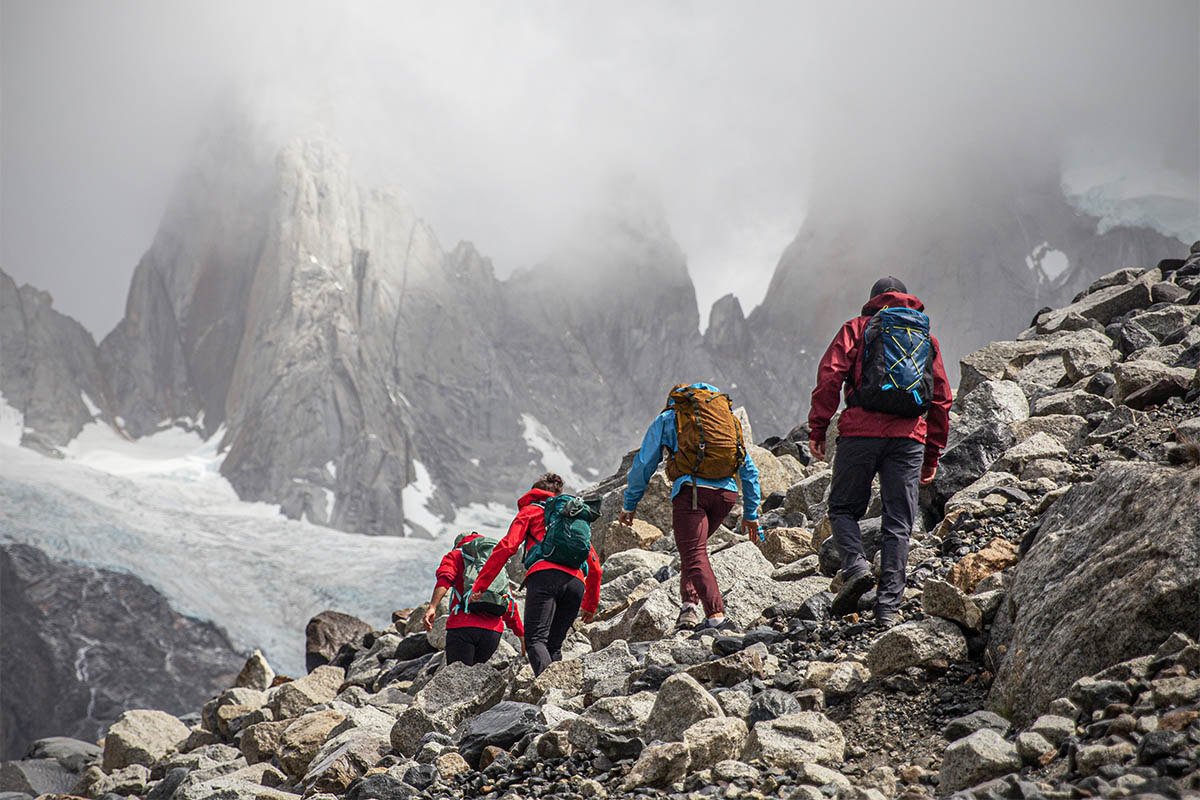
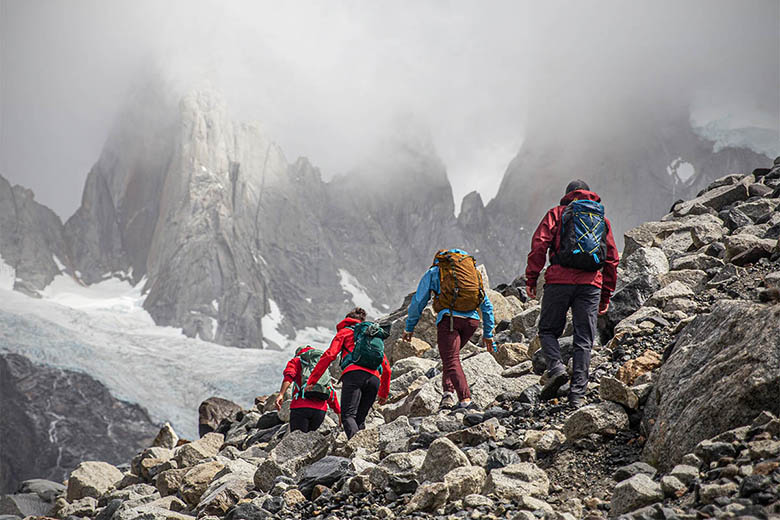
From short day hikes and summit scrambles to all-day adventures into the backcountry, you’ll want the right pack for the job. Most people carry water and food, a layering piece and rain shell, and a few other accessories like a first-aid kit or headlamp. And the longer you’ll be on the trail, the more comfort, capacity, and features come into play. Below we break down the 19 best daypacks of 2025, from simple and inexpensive models for casual hikes to more comfortable and feature-rich options for longer excursions. For more information, check out our detailed buying advice and comparison table after the picks, along with details about our testing process. Finally, while the guide below covers both men’s and women’s styles, we’ve also compiled a separate round-up of the best women’s daypacks.
Editor’s note: We updated this guide on April 10, 2025, to add Nemo’s Persist 30L to our list and swap three packs to their latest versions: the Osprey Talon, REI Traverse, and Deuter Speed Lite (which is now the Speed Lite Pro). We also incorporated fresh photos from recent testing and ensured all links and specs were accurate at the time of publishing.
 Weight: 2 lb. 6.1 oz.
Weight: 2 lb. 6.1 oz.
Capacities: 11, 22, 26, 33, 44L
Hipbelt: Cushioned, 2 zippered pockets
What we like: A comfortable, well-built, and versatile daypack.
What we don’t: For heavy loads, the Osprey Stratos below offers more padding and support.
If you’re looking for one daypack that can do it all, Osprey’s Talon is your best bet. At 22 liters (and made in larger versions up to 44 liters for those who need more capacity), it hits an ideal balance of comfort and features. Notably, the Talon has a real hipbelt with light cushioning, which is more comfortable than the simple webbing you get with more streamlined packs, along with a thoughtfully designed mesh backpanel. The pack also has functional organization—including dedicated attachment points for trekking poles, ice tools, a helmet, and a bike light—that make it a viable multi-sport option. For day hikes, travel, and everyday use, the Talon 22 is an excellent choice.
While the Talon is Osprey’s best all-rounder, the more expensive Stratos collection below offers even more padding and carrying comfort. The latter has a more substantial hipbelt along with a suspended mesh backpanel for superior support and ventilation (it’s built more like a backpacking pack than a daypack). On the flip side, the Talon is lighter at just over 2 pounds, but its thinner backpanel means you can sometimes feel the contents of your bag on your back, particularly if loaded down. In the end, the Stratos gets the edge for heavy loads and long days on the trail (the 36L we have listed is even serviceable for light overnights), but the Talon here is lighter, cheaper, and more than enough daypack for most people and uses. Osprey also offers the popular design in a couple newer variations: the more technical Talon Pro and running vest-inspired Talon Velocity (both of which come in women’s versions, too).
Read more: Osprey Talon 22 review (prior version)
See the Osprey Talon 22 See the Women's Osprey Tempest 22

 Weight: 14.0 oz.
Weight: 14.0 oz.
Capacities: 18, 22L
Hipbelt: Webbing, no pockets
What we like: Lightweight, well made, and cheap.
What we don’t: Underbuilt for shuttling a full load.
REI Co-op’s Flash line of daypacks has been a mainstay among hikers, travelers, and those on a budget for years, and the latest Flash 22 is more competitive than ever. Simplicity wins out here: The Flash 22 is frameless by design, meaning it lacks the rigidity of other daypacks but manages to keep weight extremely low at just 14 ounces (and even less if you take out the back pad or sternum strap). You don’t get a cushy hipbelt or shoulder straps, but the padded mesh along the back and shoulders does a good job at keeping you comfortable when carrying lighter loads. Perhaps most importantly, the Flash costs just $60, is well built overall, and has enough capacity for all-day outings on the trail (provided you pack relatively light).
As we touched on above, the latest Flash 22 is a nice upgrade over past versions of the pack. For starters, it utilizes more environmentally friendly materials, including recycled and bluesign-approved nylon. The top lid also now includes two buckles rather than one for snugging things down, and the Packmod bungee can be moved up or down to customize gear attachments. Finally, we love the hidden zippered pocket next to the backpanel—it’s a really handy place to store small valuables like a phone and wallet. But some downsides remain: The Flash 22 isn't a standout in comfort or support for shuttling a heavy load over long distances, materials are on the thinner end for rough use, and it’s only sold in one size. But if you can keep weight to a minimum, the Flash 22 is a great way to go fast and light on a budget. For an even lighter and more streamlined version, check out REI’s $20-cheaper Flash 18.
Read more: REI Co-op Flash 22 review (prior version)
See the REI Co-op Flash 22

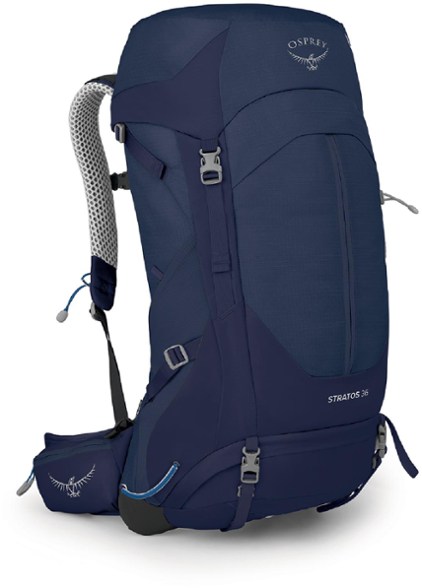 Weight: 3 lb. 4.5 oz.
Weight: 3 lb. 4.5 oz.
Capacities: 24, 34, 36, 44L
Hipbelt: Cushioned, 2 zippered pockets
What we like: Extremely comfortable, loaded with features, and can pull double duty for light overnights.
What we don’t: Heavy for the capacity and no longer offered in multiple sizes.
If you prioritize comfort or plan on hauling a heavy load, the Osprey Stratos 36 is one of the most feature-rich daypacks on this list. Its full metal frame and substantial hipbelt put the weight comfortably on your hips, and a large mesh panel ventilates extremely well and conforms nicely to your back. In addition, organization is excellent—we particularly like the two hipbelt pockets and zippered side panel access to the main compartment, and there’s even a sleeping bag compartment and pad straps for embarking on minimalist overnights. Add a built-in rain cover, and the Stratos checks off everything you’ll need in a daypack—and more.
Osprey revamped the Stratos and women’s Sirrus collections a few seasons back, and we think most of the updates were positive. In addition to using more eco-friendly materials, the latest packs got a boost in breathability with minor changes to the backpanel design. Osprey did do away with the multiple sizing options, although the ladder-like system at the back is a decent substitute and allows you to quickly adjust the torso length by up to 4 inches. The primary downsides are still weight and price: The Stratos 36 checks in at over 3 pounds (it’s even heavier than many backpacking packs) and is expensive for the capacity at $220. In the end, those wanting a premium, luxurious pack will appreciate the support and build quality of the Stratos, but for something simpler and more packable from Osprey, see the equally popular Talon above. Alternatively, the 24-liter Stratos retains a lot of what we love about the larger versions—including great comfort and organization—at a lower weight (2 lb. 12.4 oz.) and price ($180).
See the Osprey Stratos 36 See the Women's Osprey Sirrus 36
 Weight: 2 lb. 0.2 oz.
Weight: 2 lb. 0.2 oz.
Capacities: 18, 22, 30L
Hipbelt: Cushioned, 2 pockets (1 zippered, 1 open mesh)
What we like: Great mix of storage, convenience, and comfort with an included hydration system.
What we don’t: Small hipbelt pockets, only sold in one size, and many hikers already own a reservoir.
Most modern daypacks come with dedicated storage for a water reservoir, but Osprey’s Skarab 30 (and women’s Skimmer 28) provides a functional all-in-one option for those who want to purchase their pack and bladder together. In testing the Skarab, we were especially impressed by its comfort and convenience, including a spacious main compartment with a large bucket-style opening, nicely cushioned yet low-profile suspension system, and convenient organizational layout. For reference, the included 2.5-liter Hydraulics LT reservoir is a $42 investment on its own, making the Skarab a really good value for those who don’t already own a bladder. Added up, it’s another high-quality and well-appointed design from one of the best pack manufacturers around.
The Osprey Skarab 30 tops our hydration pack round-up for this year, but it’s not without downsides. First, the hipbelt pockets are noticeably small and couldn’t accommodate our standard-sized iPhone. Second, both the Skarab and women’s Skimmer are only offered in a single torso size, which will make it harder for some to dial in fit. But these are relatively small complaints for an otherwise well-equipped and highly comfortable daypack, and the included reservoir is just the cherry on top. For a boost in support and ventilation, Osprey’s $220 Manta 34 (and women’s Mira 32) includes the same 2.5-liter reservoir, although it’s noticeably heavier and more complex than the Skarab and too overbuilt for most.
See the Osprey Skarab 30 See the Women's Osprey Skimmer 28
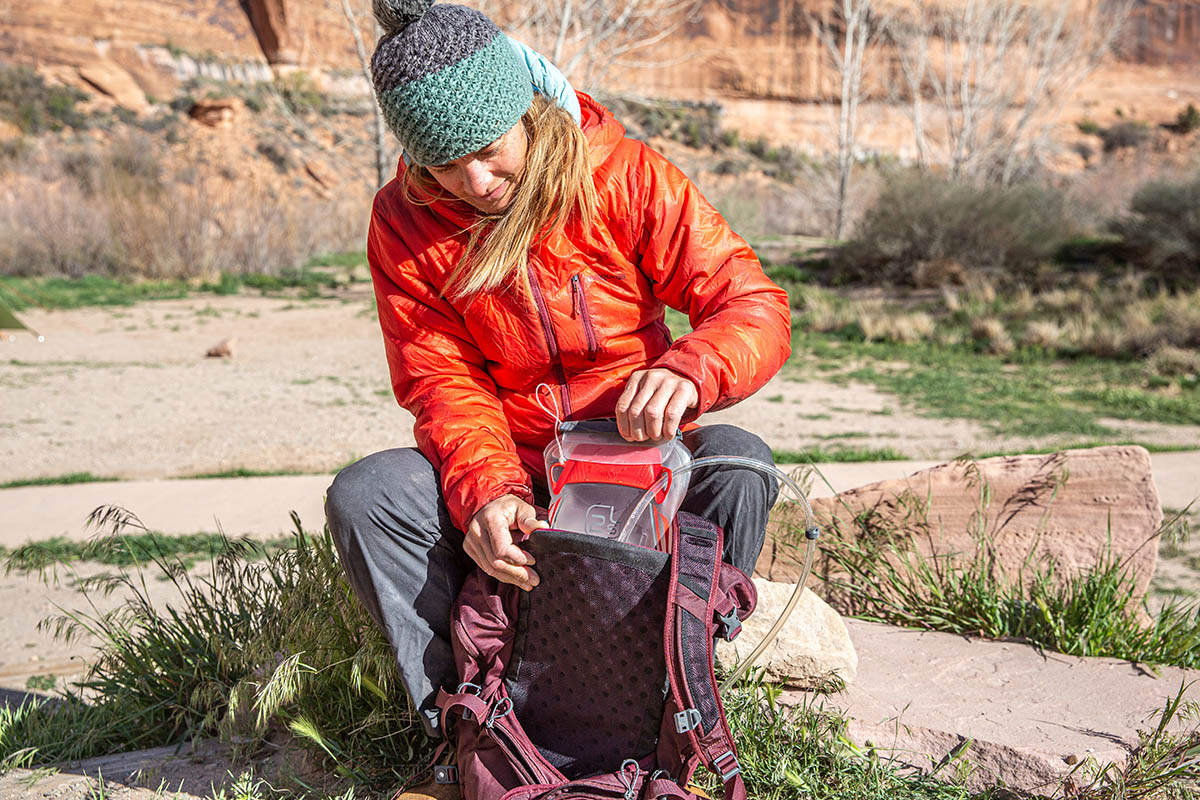
 Weight: 12.7 oz.
Weight: 12.7 oz.
Capacities: 8, 15, 22L
Hipbelt: None
What we like: Light, streamlined, and allows convenient access to the essentials.
What we don’t: Limited load support and no hipbelt.
Traditional daypacks like the Talon and Stratos above are great for moderate day hikes, but Black Diamond’s running-inspired Distance 15 is purpose-built for mountain athletes focused on traveling fast and light. The hybrid pack/vest design checks in at a scant 12.7 ounces but easily accommodates a day’s worth of supplies (it can even fit a streamlined climbing helmet). Storage is another highlight: The zippered chest pocket, trekking pole sleeves, ice axe holders, side compression straps, and multiple chest pockets allow you to conveniently access the essentials without removing the pack from your back. And with its body-hugging shape (improved with the latest version), the Distance makes it easy to move quickly and efficiently with a day’s worth of gear.
To be clear, however, the Black Diamond Distance isn’t for everyone. The pack is reasonably durable with UHMWPE (short for ultra-high-molecular-weight polyethylene) ripstop body fabrics, but you'll need to be careful around sharp rocks or equipment and avoid overpacking (we had a shoulder strap detach almost entirely after carrying too much weight). It also rides a bit low on the back and can feel heavy at the end of a long day, and the lack of hipbelt only exacerbates the issue. Importantly, the revamped Distance now comes in three sizes for both men and women, which is an improvement over the past-generation unisex pack. All told, traditional day hikers will likely want more support, but the Black Diamond is a lightweight and thoughtfully built option for those looking for a step up from a running vest. And it’s now made in a 22-liter model, which tacks on a considerable 7 liters and a large stretch woven pocket at the front.
See the Black Diamond Distance 15 See the Women's BD Distance 15

 Weight: 2 lb. 8.9 oz.
Weight: 2 lb. 8.9 oz.
Capacities: 18, 35L
Hipbelt: Cushioned, 1 zippered pocket
What we like: Excellent on-the-go storage with a supportive and body-hugging fit.
What we don’t: Very expensive and we wish Arc’teryx offered the pack in a mid-range capacity.
Arc’teryx is known for making high-quality gear for ambitious adventures, and much of that expertise has trickled down to their hiking-focused Aerios pack. We’re big fans of the fastpacking-inspired design, which merges the capacity and support of a backpack with the on-the-go storage of a running vest. On the front, you get two stretchy mesh pockets (great for storing soft flasks) in addition to more secure zippered storage on both shoulder straps. The rest of the pack offers equally convenient organization, including side dump pockets, a front stash pocket, and multiple places to securely stow valuables and accessories. Plus, suspension is excellent, pairing a vest-like fit at the chest with a rigid foam backpanel and supportive hipbelt. It all adds up to a very practical and skillfully built design, especially for hikers who prioritize speed and distance.
Arc’teryx overhauled the Aerios collection fairly recently, and we have mixed feelings about the changes. Our biggest gripe is that they trimmed the collection from three capacities (15, 30, and 45L) to two (18 and 35L), in addition to doing away with the women's version. In our opinion, packs in the 20- to 30-liter range are the most versatile option for many. Arc’teryx also streamlined the hipbelt, and both price and weight went up as a result of the increased capacity. On the flip side, the latest Aerios 35 features a more weather-ready roll-top closure (the Aerios 30 had a traditional zippered opening) that allows you to snug down a half-full load or expand storage by up to 10 liters. The technical appearance of the vest-like upper may still be a deterrent for some—the Aerios doesn’t wear particularly well on casual adventures—but you’d be hard-pressed to find a more suitable and well-built option for fast-moving trail days when you’re eating and drinking on the go.
See the Arc'teryx Aerios 35

 Weight: 3 lb. 3.0 oz.
Weight: 3 lb. 3.0 oz.
Capacities: 30, 45L
Hipbelt: Cushioned, 2 pockets (1 zippered, 1 mesh water bottle holder)
What we like: Carries a full load comfortably; well-executed technical features.
What we don’t: Expensive; overbuilt for mellow outings and casual hikers.
Nemo is a relative newcomer to the daypack space, but they’ve already made a name for themselves thanks to some notable fabric and feature innovations. Their latest offering is the Persist, which comes in 30- and 45-liter capacities and stands out for its carrying capabilities and technical intentions. After testing the smaller model in Wyoming’s Wind River Range and on subsequent trips in Utah and Nevada, we were blown away by the pack’s carrying comfort, which can be attributed to the squishy CCubed cushioning and steel frame that offers great support for full loads. What’s more, the airy DryWind backpanel kept our back sweat-free in summer-like temperatures, while the U-shaped opening made accessing the main compartment quick and easy. Rounding out the design is a practical organization layout that includes running vest-like storage at the front and a deployable water bottle holder on one side of the hipbelt. The cherry on top: The pack is built with total recyclability in mind, from production to end of life.
What’s not to like with Nemo’s latest daypack? For starters, $230 is a steep investment for a daypack, no matter how much time you spend on the trail. We think build quality lines up nicely with the price, but casual hikers and those who like to keep things mellow can save considerably with a more traditional—but still entirely capable—design like the Talon above. There’s also a bit of a learning curve to the techy design, including a unique hipbelt closure that takes some getting used to, as well as the aforementioned water bottle holder built into the hipbelt. Finally, the pack is only available in one size, although the handy torso adjustment system makes it easy to fine-tune fit if you’re within the 15- to 19-inch range. All told, the Persist is an excellent technical performer and an easy choice for our favorite new release of the season.
Read more: women’s Nemo Persist 30L review
See the Nemo Persist 30L See the Women's Nemo Persist 30L

 Weight: 1 lb. 4.6 oz.
Weight: 1 lb. 4.6 oz.
Capacities: 13, 20L
Hipbelt: Webbing, no pockets
What we like: Osprey quality and 20 liters of capacity at a good price.
What we don’t: Limited support and only sold in one size.
Osprey’s Talon and Stratos above get the lion’s share of the attention, but the Daylite Plus is another viable option that comes in significantly cheaper. This simple daypack weighs just 1 pound 4.6 ounces, has a respectable 20-liter capacity and good padding for carrying lighter loads, and boasts the kind of quality build that Osprey in known for. In terms of best uses, we’ve found that the Daylite Plus is a great match for short to moderate days on the trail or as a companion pack for travel—it’s designed to attach to the outside of a number of Osprey’s larger travel bags, including the popular Farpoint (and women’s Fairview) series.
The most obvious drawbacks to the Osprey Daylite Plus are the lack of support and sizing options (the one-size-fits-all design can accommodate 15- to 22-in. torso lengths and 25- to 50-in. waists). As we noted above, the shoulder straps are thinly cushioned and will get the job done for minimalists, but those planning to stuff in a full day’s worth of gear—including a shell, insulation, food, water, and other necessities—will quickly notice the drop in comfort. The waist belt is also made of simple webbing, which again is serviceable for brief outings but falls short as the miles add up. But as a streamlined grab-and-go option that can also be worn for travel and around-town use, the Daylite Plus (and smaller 13-liter Daylite) is undeniably a great value from one of the most reputable pack manufacturers in the business.
Read more: Osprey Daylite Plus review (prior version)
See the Osprey Daylite Plus
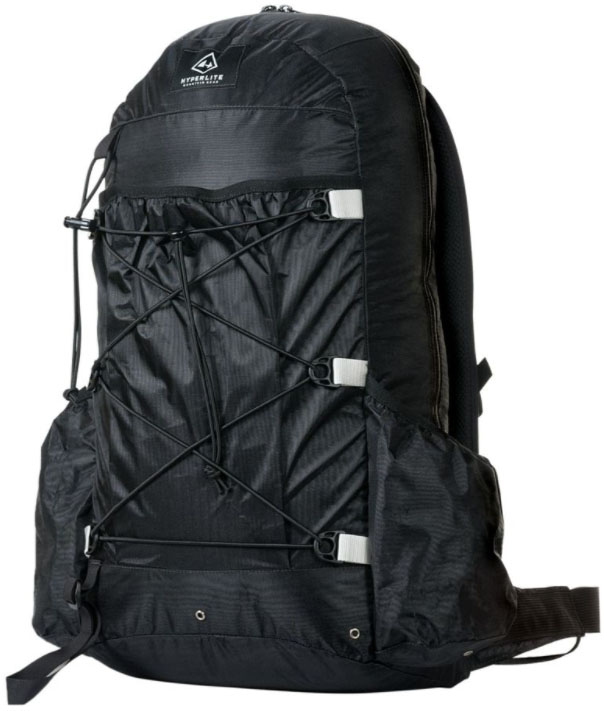 Weight: 1 lb. 4.9 oz.
Weight: 1 lb. 4.9 oz.
Capacity: 17L
Hipbelt: Cushioned, no pockets
What we like: Ultralight, weather-ready, and comfortable.
What we don’t: Very pricey and limited back ventilation.
Maine-based Hyperlite Mountain Gear makes some of our favorite ultralight backpacking packs. Their top daypack, the Daybreak 17, shares the same core ingredients: A Dyneema construction (technically, Dyneema Composite Hybrid—DCH for short) that’s highly weather-resistant and incredibly strong for its weight, simple yet functional organization, and a clean design that looks great. On paper, the 17-liter capacity in the main compartment seems small, but the large front pocket and two side pockets add a significant amount of functional storage. For serious day hikes in rough conditions, the Daybreak is hard to beat.
At $229, the Daybreak is one of the priciest bags on our list despite only having a modest 17-liter capacity. As we noted, the external pockets do add another 6 liters of storage, but those looking for a cavernous main compartment might prefer Hyperlite’s 22-liter Elevate, which is a few ounces lighter and boasts a more weather-ready roll-top closure for $20 more. However, after testing the Elevate in Patagonia last year, we came away underwhelmed with its organization: The main compartment is bereft of pockets, there’s no sleeve for stashing a hydration bladder or laptop, and the front shove-it space lacks the stretch needed to accommodate bulkier items like extra layers. In our opinion, the Daybreak is the more complete and versatile design. In fact, many people (ourselves included) even use it as an everyday/commuter pack, which makes it easier to swallow the high price tag.
Read more: Hyperlite Mountain Gear Daybreak 17 review
See the Hyperlite Mountain Gear Daybreak 17
 Weight: 3 lb. 4.0 oz.
Weight: 3 lb. 4.0 oz.
Capacities: 35, 60L
Hipbelt: Cushioned, 2 zippered pockets
What we like: Durable materials, three size options, and a good all-around value.
What we don’t: Overbuilt and too many features for most day hikes.
The second REI pack to make our list is the Traverse 35, which is a shrunken-down variation of their popular 60-liter backpacking pack. In a strong departure from the minimalist Flash 22 above, the focus here is on durability and organization: The Traverse is solidly built with a steel frame and hardwearing fabrics (bonus: they’re recycled and bluesign-approved), and you get ample exterior pockets, a handy side-access zipper to the main compartment, and lash points for stowing gear and valuables. The latest iteration of the Traverse forgoes REI’s Packmod system, which allowed you to customize the compression strap layout depending on the size and shape of your load, but it’s not a huge omission, and we appreciate that REI kept the price the same despite making the pack bigger by 3 liters.
That said, not everyone will benefit from the Traverse’s unapologetically burly and complex build. Weight is fairly reasonable for the capacity at 3 pounds 4 ounces, but the thicker fabrics and raised foam padding on the backpanel give the bag a fairly clunky feel (this also translates to subpar breathability). For most easy-to-moderate day hikes, we would prefer shaving considerable heft and bulk with a design like Osprey’s Talon above. That said, the Traverse has its appeal for ambitious all-day treks and light overnights, and the three size options mean that many hikers will be able to find a good fit. For a bigger but slightly less technical design, check out REI’s Trail 40 below.
See the REI Co-op Traverse 35 See the Women's REI Traverse 35
 Weight: 1 lb. 8.0 oz.
Weight: 1 lb. 8.0 oz.
Capacities: 19, 25, 30L
Hipbelt: Cushioned, 2 zippered pockets
What we like: Competitive mix of weight, comfort, and features.
What we don’t: Availability can be hit or miss; women’s versions are smaller but cost the same.
Deuter’s Speed Lite has been a mainstay in the daypack market for years, and the latest Pro offerings build upon the proven design. The 25-liter pack here is an ideal size for most day hikes, is both comfortable and breathable, and comes with all the requisite features, including trekking pole holders, side compression straps, and hydration reservoir compatibility. And despite being a little bigger than the Talon 22 above, the Speed Lite Pro is a significant 14.1 ounces lighter and $30 cheaper, making it a solid overall value for the capacity. You can even upgrade to the reservoir-equipped Speed Lite Pro 25 Hydro, which includes a 2-liter HydraPak bladder for $5 less than the Talon. A final bonus: The new pack uses recycled, bluesign-certified fabrics and a PFAS-free DWR coating, which only add to all-around appeal.
Like the BD Distance, Arc’teryx Aerios, and Nemo Persist above, the Speed Lite Pro 25 features running vest-like pockets along the shoulder straps. One side features a zippered pocket that can swallow a smartphone, while the other unzips to reveal a soft flask pouch with a bungee loop for keeping it in place. We consider these pockets to be much more practical than the dual zippered pockets on the past-generation Speed Lite 25, which were too flat and narrow to fit more than a couple gels or a pair of kids’ sunglasses. Deuter also included dual hipbelt pockets this time around, both of which are zippered. Our only real complaints relate to availability and sizing: Deuter packs can be trickier to track down compared to offerings from brands like Osprey and REI, and the women’s versions of the pack (called the Speed Pro SL) offer less capacity than the men’s models without a reduction in cost. Still, the Speed Lite Pro is a comfortable and nicely appointed day hiking design at a good price, earning it a spot on our list this season.
Read more: Deuter Speed Lite Pro 23 SL review (Hydro version)
See the Deuter Speed Lite Pro 25 See the Women's Speed Lite Pro 23 SL
 Weight: 3 lb. 0.6 oz.
Weight: 3 lb. 0.6 oz.
Capacities: 30, 45, 55, 65L
Hipbelt: Cushioned, 2 zippered pockets
What we like: Well-rounded high-capacity design that's a legitimate competitor to Osprey’s Stratos above.
What we don’t: Heavy; not as overnight-friendly as the Stratos.
Gregory goes head-to-head with Osprey in the daypack and backpacking pack markets, and their Zulu 30 is a serious competitor to the popular Stratos above. In short, the Zulu has all the trimmings we’d expect of a premium day-hiking design, including the brand’s FreeFloat dynamic suspension system and mesh backpanel for great all-around comfort and breathability. Further, you get well-thought-out organization, easy access to the main compartment via a large U-shaped opening, and three handy stretch mesh pockets on the exterior. We also love the adjustability at the torso, which can be moved up or down 3.5 inches. Finally, the Gregory is built to last with robust materials throughout and reinforced panels along the bottom.
The Zulu comes in a range of capacities up to 65 liters, but the 30-liter version here is our favorite day hiking option with its sleek bucket-style opening and streamlined shape (the larger capacities feature a floating lid). That said, it’s particularly heavy for a daypack, and the aforementioned Stratos 36 offers more versatility for overnights: On top of the additional 6 liters of capacity, you get a more featured storage layout, including a zippered front panel and dedicated sleeping bag compartment with a floating liner. That said, while the Stratos line comes in a 24-liter version, the Zulu collection doesn’t include any options in the 20-liter range for day hikers who like to stick to the basics (although Gregory does now offer a few “LT” variations that range from 20 to 28 liters). But if 30 liters is your sweet spot, there’s no denying the Zulu’s impressive comfort, ventilation, and feature set.
See the Gregory Zulu 30 See the Women's Gregory Jade 28
 Weight: 2 lb. 14.0 oz.
Weight: 2 lb. 14.0 oz.
Capacities: 25, 40L
Hipbelt: Cushioned, 2 zippered pockets
What we like: Massive interior, excellent organization, and included rain cover at a great price.
What we don’t: On the heavier end; loses a lot of its structure when the lid is full.
We’ve used quite a few REI daypacks over the years and consider them a solid value for their feature set. Along with the Flash and Traverse packs above, the Trail 40 is an excellent example: For $149, you get outstanding organization with a generous 40-liter main compartment (the largest daypack to make our list), ample exterior pockets and lash points, great touches like trekking pole attachments and an included rain cover, and specific men’s and women’s designs. The pack is also nicely built with durable materials that are recycled and bluesign-approved, along with plush cushioning along the backpanel, hipbelt, and shoulders. And we love the U-shaped opening that extends down the sides, which allows you to access the bottom of the main compartment without having to pull out everything on top. Taken together, it’s a whole lot of bang for your buck.
As we mentioned, the REI Trail 40 is the largest option here, which has its pros and cons. On the bright side, you should have no trouble stashing a full day’s worth of gear, including extra layers and plenty of water and snacks. It also crosses over nicely for travel and can even pull double duty for light overnights (provided you pack strategically). On the other hand, the Trail 40 checks in at a fairly hefty 2 pounds 14 ounces and lacks structure when fully unzipped, especially if the lid is weighted down with gear. But if you plan to carry a lot and don’t mind the weight penalty, the Trail 40 stands out as a highly versatile and affordable option for day hikes, commuting, minimalist overnights, or as a carry-on while traveling. REI also makes a smaller 25-liter version for $100, although the basic webbing hipbelt detracts from support.
Read more: women's REI Co-op Trail 40 review
See the REI Co-op Trail 40 See the Women's REI Trail 40
 Weight: 3 lb. 3.2 oz.
Weight: 3 lb. 3.2 oz.
Capacities: 26, 36L
Hipbelt: Cushioned, 2 zippered pockets
What we like: Fully waterproof, comfortable suspension, and thoughtful organization.
What we don’t: Relatively heavy, lacking in breathability, and the priciest design here.
Hate having to desperately rip out a rain cover every time a freak storm rolls in? Or maybe you're after top-shelf protection for sensitive gear on wet missions? Whatever the forecast or objective, Osprey's Downburst will keep your precious cargo safe and sound. Boasting an impressive IPX5 waterproof (non-submersible) rating with a welded and PU-laminated construction, you get the confidence-inspiring protection of a dry bag alongside the carrying comfort and thoughtful organization that Osprey is known for. We recently brought the 26-liter Downburst, which is also available in a 36-liter version, to Wyoming's Wind River Range for testing and came away highly impressed. The padded shoulder straps and hipbelt carried a full load with ease, and we had no trouble stashing a full team lunch along with the other requisite gear. It's true that the Downburst is no small investment at $300, but it's an undeniably premium pack with the performance to back it up.
The headliner here is obviously the pack's waterproof build. Since conditions were favorable on our day hike in Wyoming, we put the Downburst through a shower test back home to gauge its protection. Filling each compartment with dry clothes and other gear, we soaked the bag for over five minutes before opening the main compartment to find the contents bone-dry. One of the hipbelt pockets did let some moisture through, but the type of deluge we subjected the pack to isn't a common occurance, in reality. Truly, the only complaints we have are the Downburst's heft, steep price tag, and relative lack of breathability, which isn't too surprising given its focus on all-out protection. All in all, if you often find yourself worrying about the gear in your daypack staying dry, the Downburst could be the perfect solution.
See the Osprey Downburst 26 See the Women's Downburst 24
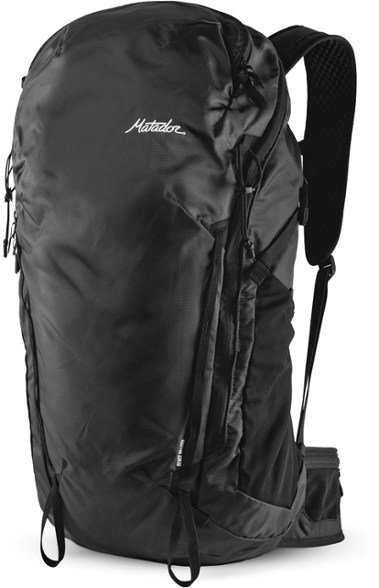 Weight: 1 lb. 8.0 oz.
Weight: 1 lb. 8.0 oz.
Capacities: 18, 28L
Hipbelt: Cushioned, 2 zippered pockets
What we like: Impressively tough and light for the capacity.
What we don’t: Overly technical for some.
Boulder, Colorado-based Matador is an upstart on the rise and has quickly made a name for themselves in the travel market with a nice selection of light but dependable packs and duffel bags. Their daypack lineup follows suit, including the popular Beast28 here. What immediately stands out is the Beast’s competitive 1-pound-8-ounce weight, which is impressively light for the capacity and undercuts more traditional (and smaller) models like the Osprey Talon 22 (2 lb. 6.1 oz.), Deuter Speed Lite Pro 25 (1 lb. 8 oz.), and others above. It also packs down remarkably small for stashing in a duffel for travel—Matador includes a handy compression sack for storage, and both the hipbelt and sternum strap can be removed to streamline your kit even further. Finally, while many ultralight packs compromise on durability, the Beast is noticeably well-built with a tough (210D) Robic nylon build, water-resistant YKK zippers, and a UTS coating for waterproofing and tear resistance.
In addition to being impressively light and durable for the size, the Matador Beast28 is also surprisingly comfortable for a UL design. The backpanel, shoulder straps, and hipbelt are all nicely cushioned with EVA foam, and the flexible steel frame adds a good dose of support while keeping weight in check (it also helps with compressing the pack down for storage). That said, the Beast has a fairly technical appearance that doesn’t wear particularly well around town and is only offered in a single black colorway. Exterior storage is also a little lacking, including just three pockets on the outside—for $10 more, Osprey’s Talon 22 above boats six exterior pockets. But if you don’t mind stuffing most of your gear in the main compartment, the Beast28 stands out as a high-quality UL option for fast-moving day hikes and short mountain missions.
See the Matador Beast28
 Weight: 1 lb. 3.4 oz.
Weight: 1 lb. 3.4 oz.
Capacities: 18, 22L
Hipbelt: Webbing, no pockets
What we like: Included 3L water reservoir makes it a standout value.
What we don’t: Less comfortable and feature-rich than the Osprey Skarab above.
Gregory has been in the pack business for decades, and we’re consistently impressed with the build quality and comfort of their products. The Nano H2O hydration pack is no exception and has a hiking-focused build that comes with Gregory’s in-house 3D Hydro reservoir system. There’s a lot to like here: The Nano is lightweight, sleek, and very competitively priced at just $90 (the included reservoir costs $45 alone). You can spend up for Gregory’s Inertia 24 hydration pack, which comes with nice touches like a lightly padded hipbelt, more supportive foam backpanel, and more generous storage layout, but we love the value of the Nano line.
Compared with the Osprey Skarab 30 hydration pack above, the Gregory Nano H2O is a little smaller but includes a larger 3-liter reservoir (the Skarab’s is 2.5L) and costs a considerable $60 less. Where the Skarab gets the clear edge is carrying abilities with a stiffer, more supportive backpanel. It also has good padding and pockets on the hipbelt along with a more form-fitting design. But for shorter hikes with lighter loads, the Nano H2O is a great alternative for less money. For a more feature-rich hydration option from Gregory with excellent carrying comfort, check out their premium Citro 24. And for those who already own a hydration bladder, Gregory also offers a version of the Nano sans reservoir, which features a slightly different design and comes in capacities from 14 to 28 liters.
See the Gregory Nano 22 H2O
 Weight: 12.0 oz.
Weight: 12.0 oz.
Capacities: 16, 24L
Hipbelt: None
What we like: Light and eye-catching design with a strong focus on sustainability.
What we don’t: Limited usefulness on anything but short and casual hikes.
Salt Lake City-based Cotopaxi is a brand on the rise, combining sustainable production practices with fun, vibrant designs for casual outdoor-goers. Their Batac 16L daypack slots in as a budget-friendly and feathery option for minimalists and short day-hiking objectives. For reference, it’s the lightest option on our list at a scant 12 ounces (undercutting the Flash 22 above by 2 oz.) and has a streamlined, body-hugging shape that keeps the pack close to your back. Storage is also surprisingly good for how small and light the pack is, including a vertical front zippered pocket, two mesh water bottle pockets, exterior attachment loops, and an internal sleeve for a reservoir or laptop. Added up, it’s a sleek, good-looking option at a very affordable price point and can easily pull double duty for commuting and travel.
That said, the performance drawbacks are enough to push the Batac toward the end of our rankings. Despite the functional storage layout, the design still is decidedly basic with a frameless build, no hipbelt, and minimal padding along the shoulder straps. For reference, REI’s similarly sized Flash 18 costs $25 less, weighs 9.5 ounces, and boasts a basic webbing hipbelt for a little added support, while their $60 Flash 22 above is noticeably more comfortable and feature-rich. On the flip side, the Cotopaxi wins out in styling with its bright, multi-colored design and is made from 100%-repurposed fabrics—two of the brand’s hallmarks. Given the light and sleek build, it’s also a viable follower pack for multi-pitch climbs. The lack of support and cushioning are undeniably limiting, but it’s a thoughtfully built option at a good value for shorter adventures and summit scrambles. For a simpler option from Cotopaxi, check out their popular Luzon 18L.
See the Cotopaxi Batac 16L
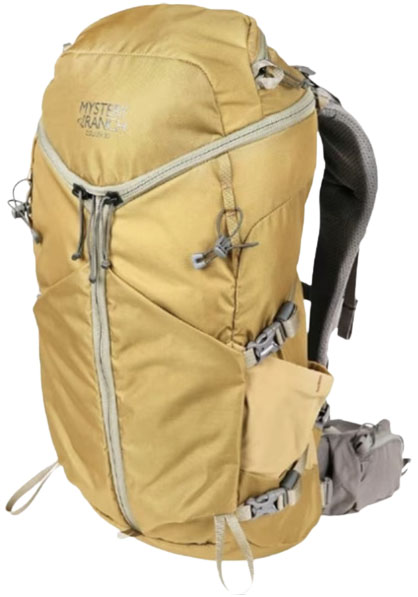 Weight: 2 lb. 11.2 oz.
Weight: 2 lb. 11.2 oz.
Capacities: 20, 30, 40, 50L
Hipbelt: Cushioned, 2 zippered pockets
What we like: Unique zipper design allows easy access and has a lot of appeal for travel.
What we don’t: Not as featured as the Stratos above.
Mystery Ranch is a cottage brand out of Bozeman, Montana, with a solid reputation among hunters and serious mountain athletes. For the casual day-hiking crowd, their Coulee 30 stands out as an impressively durable and functional option. Right away, you’ll notice that this pack looks a little different than the competition: With a unique, Y-shaped opening at the front, the Coulee opens wide and allows quick and easy access to the main compartment. From day hiking to international travel, the 3-zipper system has a lot of appeal, and the rest of the design and storage layout are equally well executed.
With a well-built harness and hipbelt and capacities that run as large as 50 liters, the Coulee is a viable competitor to the Osprey’s Stratos above. The Stratos offers a more traditional floating-lid design, integrated rain cover, and additional storage options, but the Coulee is a considerable $31 cheaper and comes in two sizes for both men and women (the Osprey is only available in one size). All told, there’s a lot to like about the unique Coulee, and with revitalized colorways and a sleek exterior, the newest version is also a great crossover option for everyday use. And if you like the zipper design but are looking for something a little different, check out Mystery Ranch’s Gallagator, Scree, and Catalyst collections.
See the Mystery Ranch Coulee 30 See the Women's Coulee 30
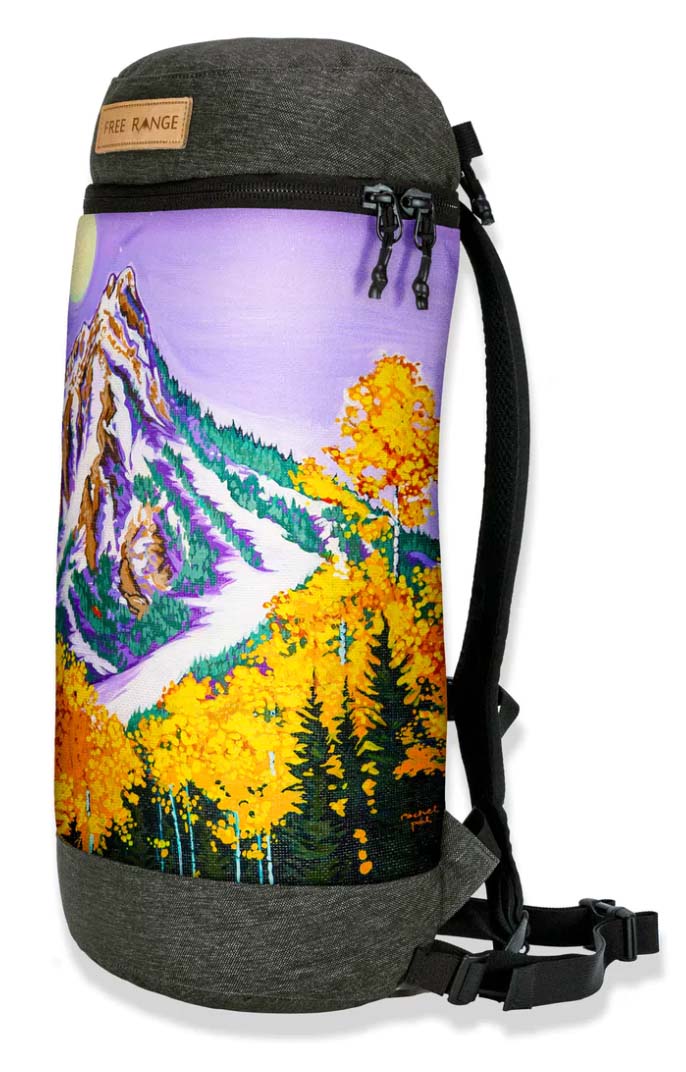 Weight: 1 lb. 3.0 oz.
Weight: 1 lb. 3.0 oz.
Capacities: 25L
Hipbelt: Webbing, no pockets
What we like: A durable canvas pack with your pick of mountain artwork; handmade in the USA.
What we don’t: Pricey and not ideal for performance use.
Most of the packs here are fairly technical in nature, but Free Range Equipment (FRE) offers something a little different. A small company run out of a garage in Bend, Oregon, FRE works with artists to create each of their classic Canvas Series packs. Their list of collaborators is ever-growing, and at the time of publishing, you can choose from 20 different designs, including everything from the Tetons and Mt. Hood to an idyllic cabin scene. The Canvas pack is basic—you get 25 liters of space, a small internal stash pocket, and two zippered pockets on the lid—but it gets the job done for day hikes or your daily commute (a laptop easily fits inside).
Free Range Equipment’s Canvas packs aren’t trying to match the performance chops of the Ospreys and Deuters above, but their rugged fabric will hold up to years of use and abuse (we’ve used ours almost daily for three years with no durability concerns). Keep in mind that you don’t get features like a padded waist belt, reservoir sleeve, or numerous storage options, and the Canvas pack only comes in one size. But let’s be honest: The aesthetics and versatility are the biggest selling points of this pack, and it wins out in both departments. We should note that FRE also makes Canvas fanny packs, which feature their own unique artwork and are less of an investment at $59.
See the Free Range Equipment Canvas
| Daypack | Price | Weight | Capacities | Hipbelt | Frame | Pockets |
|---|---|---|---|---|---|---|
| Osprey Talon 22 | $160 | 2 lb. 6.1 oz. | 11, 22, 26, 33, 44L | Cushioned | Framesheet | 6 exterior |
| REI Co-op Flash 22 | $60 | 14.0 oz. | 18, 22L | Webbing | None | 3 exterior |
| Osprey Stratos 36 | $220 | 3 lb. 4.5 oz. | 24, 34, 36, 44L | Cushioned | Alloy frame | 7 exterior |
| Osprey Skarab 30 | $150 | 2 lb. 0.2 oz. | 18, 22, 30L | Cushioned | Framesheet | 5 exterior |
| Black Diamond Distance 15 | $180 | 12.7 oz. | 8, 15, 22L | None | None | 7 exterior |
| Arc’teryx Aerios 35 | $250 | 2 lb. 8.9 oz. | 18, 35L | Cushioned | Framesheet | 7 exterior |
| Nemo Persist 30L | $230 | 3 lb. 3.0 oz. | 30, 45L | Cushioned | Steel frame | 7 exterior |
| Osprey Daylite Plus | $75 | 1 lb. 4.6 oz. | 13, 20L | Webbing | Backpanel | 5 exterior |
| Hyperlite Daybreak 17 | $229 | 1 lb. 4.9 oz. | 17L | Cushioned | None | 3 exterior |
| REI Co-op Traverse 35 | $159 | 3 lb. 4.0 oz. | 35, 60L | Cushioned | Steel frame | 6 exterior |
| Deuter Speed Lite Pro 25 | $130 | 1 lb. 8.0 oz. | 19, 25, 30L | Cushioned | Backpanel | 7 exterior |
| Gregory Zulu 30 | $180 | 3 lb. 0.6 oz. | 30, 45, 55, 65L | Cushioned | Steel frame | 4 exterior |
| REI Co-op Trail 40 | $149 | 2 lb. 14.0 oz. | 25, 40L | Cushioned | Steel frame | 7 exterior |
| Osprey Downburst 26 | $300 | 3 lb. 3.2 oz. | 26, 36L | Cushioned | Alloy frame | 6 exterior |
| Matador Beast28 | $150 | 1 lb. 8.0 oz. | 18, 28L | Cushioned | Steel frame | 3 exterior |
| Gregory Nano 22 H2O | $90 | 1 lb. 3.4 oz. | 18, 22L | Webbing | None | 3 exterior |
| Cotopaxi Batac 16L | $65 | 12.0 oz. | 16, 24L | None | None | 3 exterior |
| Mystery Ranch Coulee 30 | $189 | 2 lb. 11.2 oz. | 20, 30, 40, 50L | Cushioned | Framesheet | 7 exterior |
| Free Range Canvas | $139 | 1 lb. 3.0 oz. | 25L | Webbing | Backpanel | 1 exterior |
Hiking reviews comprise a large portion of the Switchback Travel site, and for good reason: With minimal gear required—primary necessities are a quality pair of shoes and daypack—hiking has a relatively low barrier to entry compared to other outdoor activities. Former editor-in-chief and avid outdoorsman John Ellings put together our initial lineup of 12 daypacks in 2015. Based in the Pacific Northwest, John is no stranger to rugged trails and rough weather. Managing editor Sarah Nelson began contributing to the guide in 2020. Formerly a full-time vanlifer, Sarah has logged hundreds of miles throughout the Mountain West and continues to put daypacks to the test along the shores of Lake Tahoe (where she’s currently based) and beyond. Senior editor Chris Carter also has a hand in keeping the list fresh, contributing his expertise as an experienced thru-hiker with a penchant for keeping things light but comfortable.
Our current lineup of 19 daypacks is the result of continued on-trail testing, along with feedback from our contributors and the online hiking community. When we test daypacks, we prioritize comfortable and supportive padding, breathable backpanel designs, and practical storage layouts that can fit all the essentials. We also take into account considerations like weather resistance, ease of access, and overall capacity. We know hikers’ needs vary greatly, which is why we’ve included a relatively wide variety of options above, from streamlined designs for fast-and-light missions to fully featured packs for gear-intensive days and even minimalist overnights. As we continue testing new and noteworthy daypacks, we’ll update the list above to reflect our current favorites.

With hundreds of daypacks on the market, choosing the right one is largely dependent on what you intend to use it for. Do you need a daypack to approach an alpine climbing zone, or to explore an urban area on vacation? Do you need to strap on crampons or an ice axe, or do you just want a comfortable way to haul water and some extra layers?
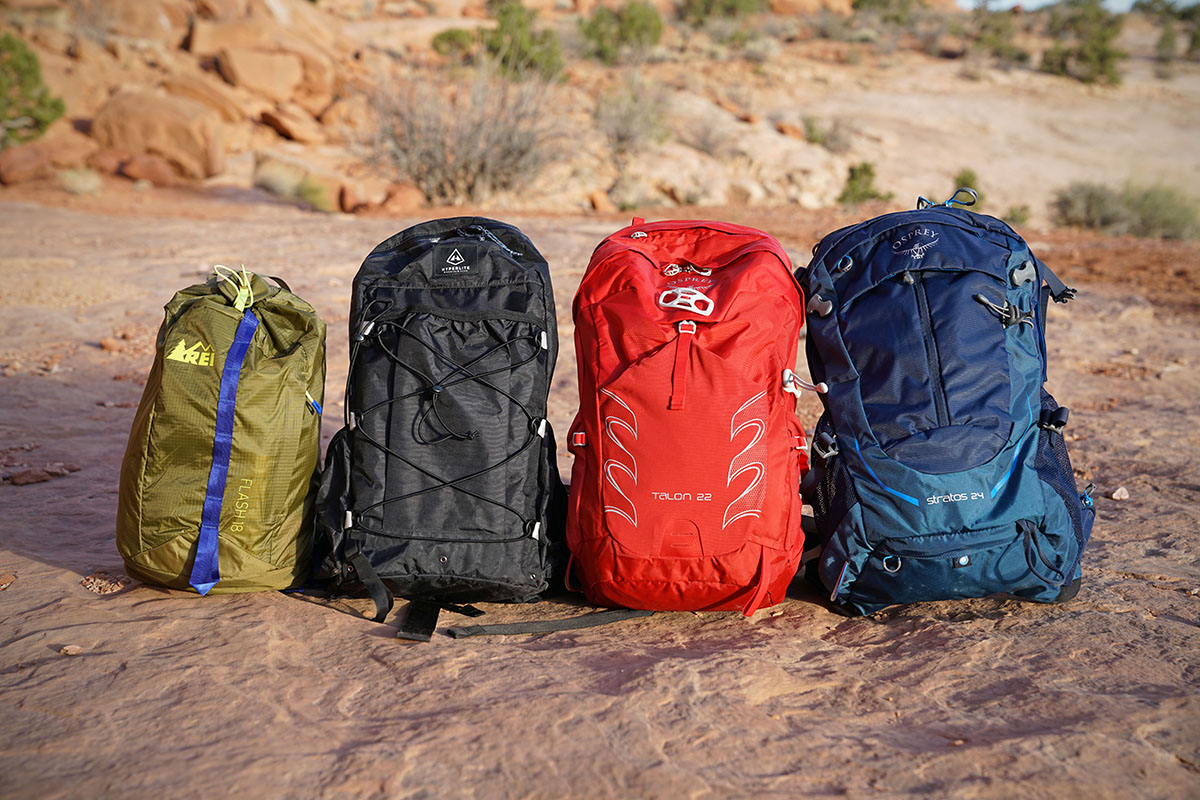
For the casual user that doesn’t need much support for hauling a heavy load, the more affordable options on this list will do just fine. Budget-friendly packs like the $60 REI Co-op Flash 22 have a more basic suspension design (or none at all) and a less customizable fit, but do great for heading to class or a quick hike in the woods. If you’re planning on going after some serious miles or need to carry a decent load, you’ll appreciate the added structure and padded backpanel, hipbelt, and shoulder straps found in the options starting around $100 (we cover this in more detail in the "Carrying Comfort" section below). Finally, many of today’s top daypacks can pull double duty for casual use.
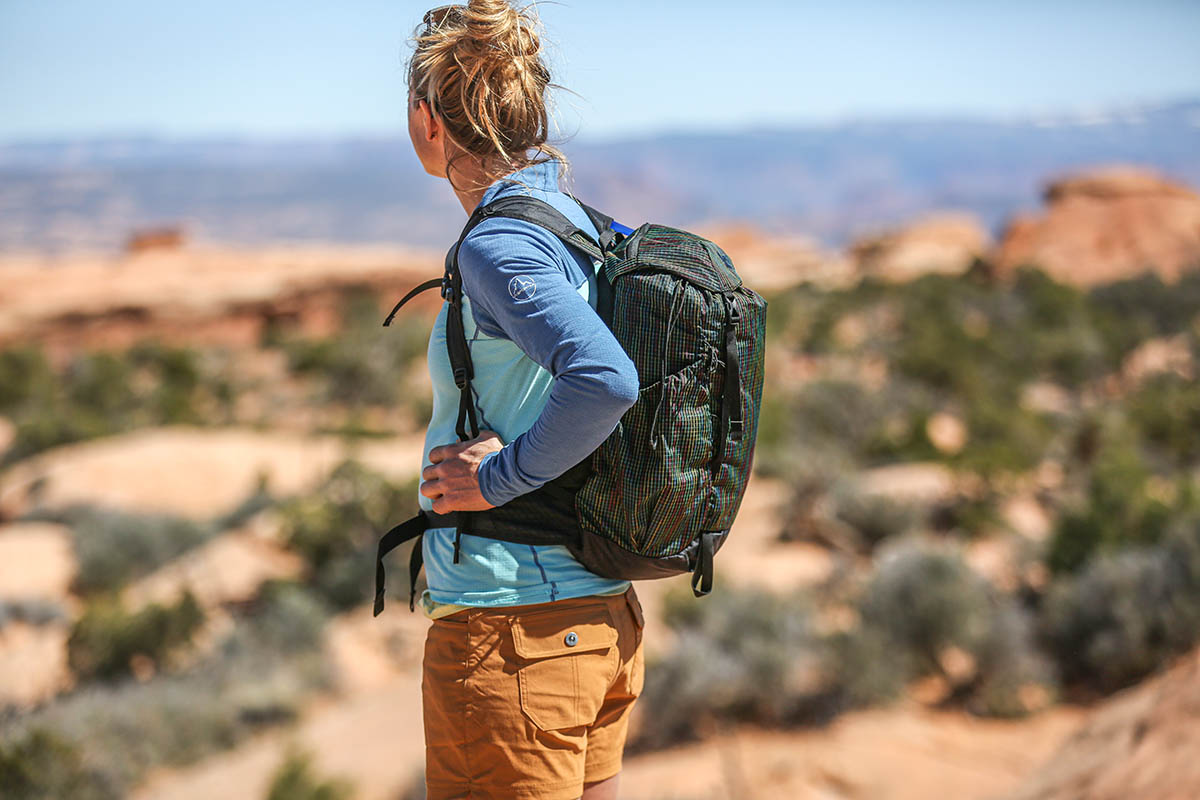
Capacities for daypacks vary widely. You’ll see them offered anywhere from as small as 5 liters all the way up to 40 or more. For those who only need to fit a compressible rain jacket and a lunch, you can get away with one of those small packs. But most of us need a bit more space to throw in a few more essentials. The options above range from 15 to 40 liters, with the largest ones being better served for commuters, gear-heavy adventures like winter hikes, or ultralight overnights. We’ve found that approximately 25 liters is a real sweet spot for an all-around daypack that can handle anything from local summits to full-day hikes. At that size, organization also improves from more basic models, with a variety of zippered pockets to divvy up your gear. Below are some basic guidelines for capacity:

A quick look at our comparison table above reveals a wide range of pack weights from a scant 9 ounces to over 3 pounds. On the heavy end is the fully featured Osprey Stratos 36, which comes with lots of zippered pockets and a suspension and hipbelt to rival a backpacking pack. At the other end of the spectrum, the REI Flash 22, Osprey Daylite Plus, Cotopaxi Batac, and Hyperlite Mountain Gear Daybreak are minimalist packs with much less in the way of structure or features but weigh about 1 pound or less. Black Diamond’s Distance 15 is another impressively light option at just 12.7 ounces, but it’s a much more specialized design with a streamlined storage layout and no hipbelt.
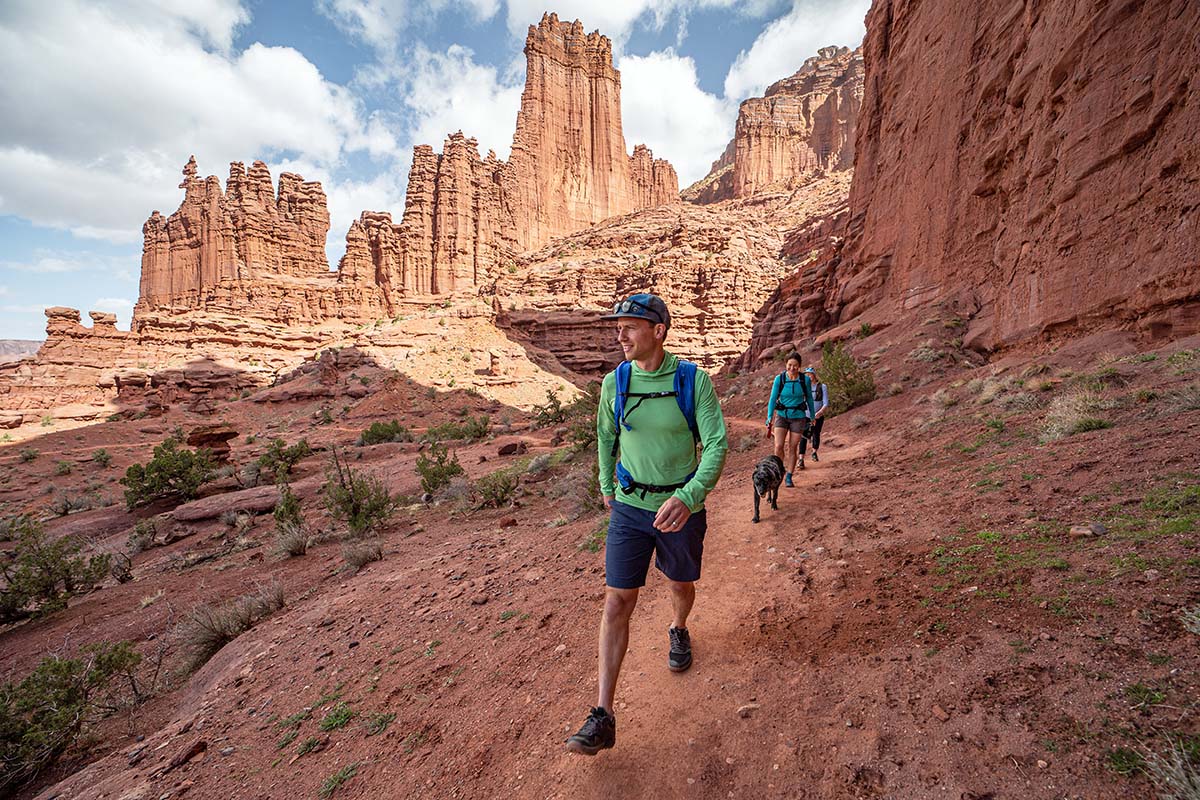
When evaluating pack weight, keep comfort and storage in mind. A fully featured pack will include padding on your back and real straps on your shoulders and waist to help distribute weight. If you’ll be carrying a lot, this will be your most comfortable option. But if you don’t mind feeling some of your gear on your back or won’t be hauling a heavy load (it is only a daypack, after all), the minimalist options on this list usually are cheaper and far more compressible (useful for throwing in a suitcase). In the end, most hikers and travelers will want something that lands in the middle and balances cushioning and weight, like the popular Osprey Talon 22 (2 lb. 6.1 oz.) and Deuter Speed Lite Pro 25 (1 lb. 8 oz.).
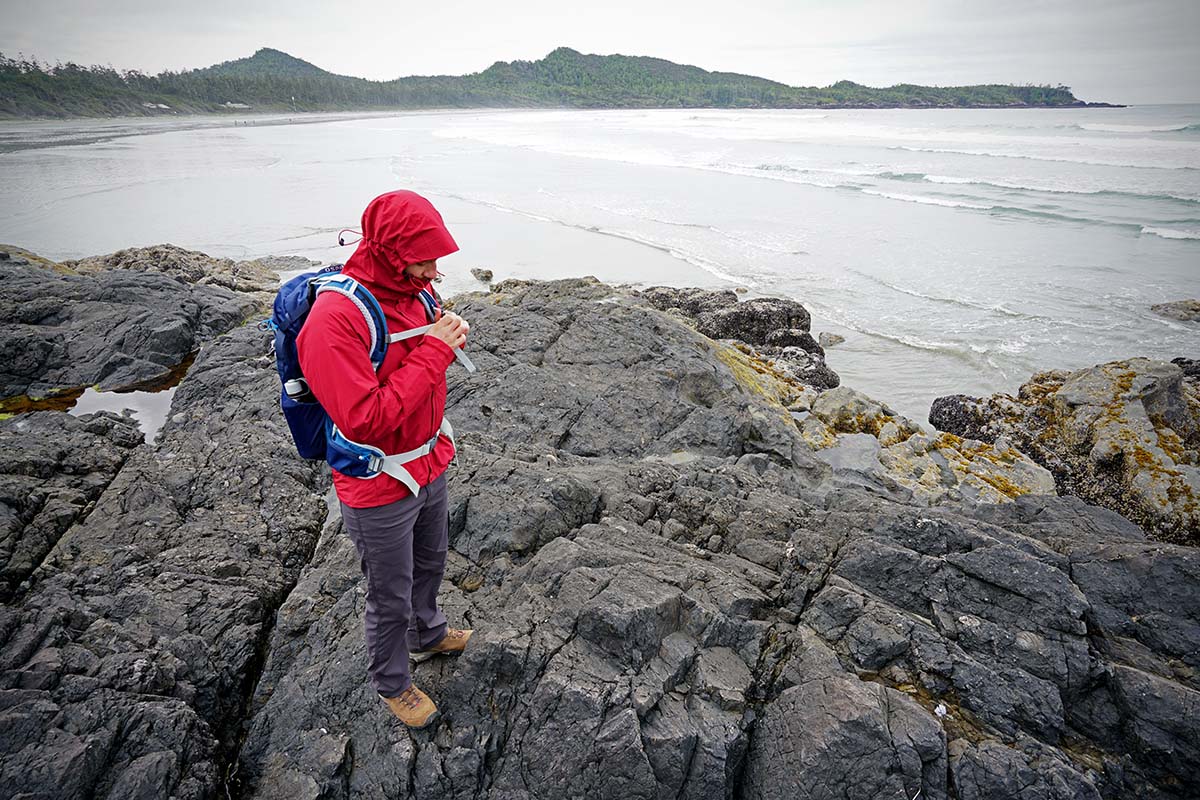
The amount of padding on the hipbelt and shoulder straps is a great indicator of a pack’s maximum comfort level. Nearly all daypacks for hiking have a hipbelt, but they vary from thin webbing (like the REI Flash series) to cushioned and supportive (Osprey Stratos). If all you need is a pack for short day hikes and don’t plan on carrying more than 10 or so pounds, the thinner webbing is sufficient. If, however, comfort reigns supreme or you plan to haul a lot of weight, we highly recommend a pack with a real hipbelt.
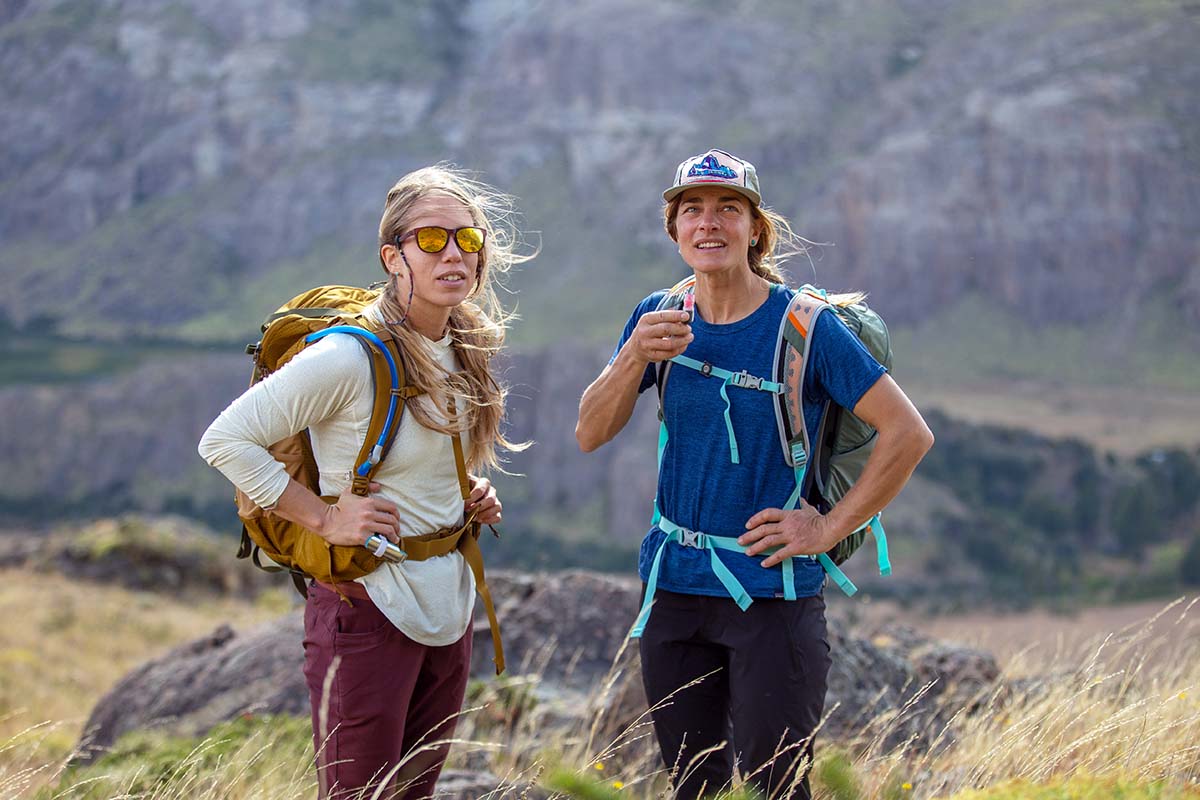
Keep in mind, thicker designs don’t compress very well and do add some extra weight. And for those planning to use their pack for both the backcountry and casually, it may be beneficial to have a removable hipbelt. We keep ours on for hiking and leave it behind when heading to town or carrying on a flight. One design that has this feature is the Osprey Daylite Plus.
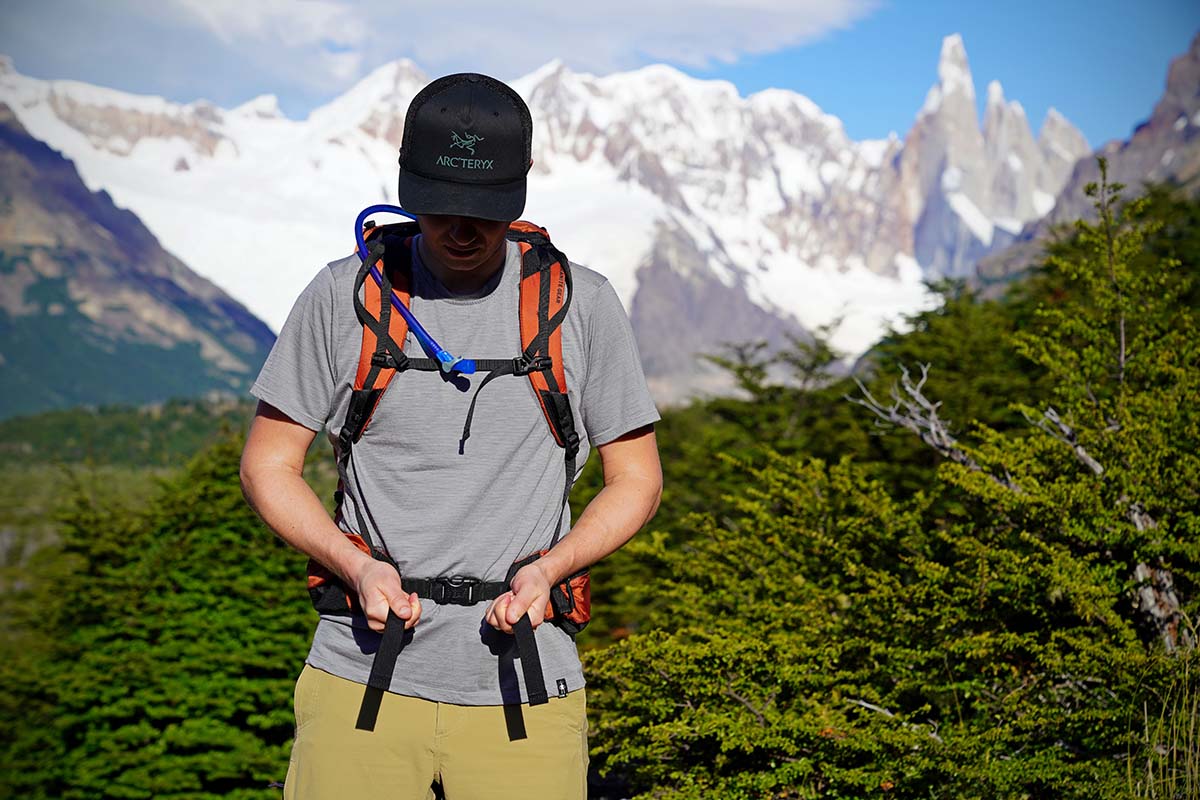
In addition to the amount of padding along the shoulder straps and hipbelt, fit plays a large role in overall comfort on the trail. Most importantly, you’ll want to ensure that your pack is the appropriate size for your torso length and that the hipbelt can be tightened to secure snugly around your hips. This is easier to achieve when a pack is offered in multiple sizes, although some designs (like the Nemo Persist) feature a torso adjustment system that spans a decently wide range (the Persist can accommodate torsos from 15 to 19 in.). If you’re eyeing a pack that has this feature or comes in multiple size options, take your torso length by measuring the distance between your C7 vertebrae and midpoint of your iliac crest (we outline the process here). Once you have that number, you can compare it against manufacturer sizing charts to confirm which variation will fit you best.
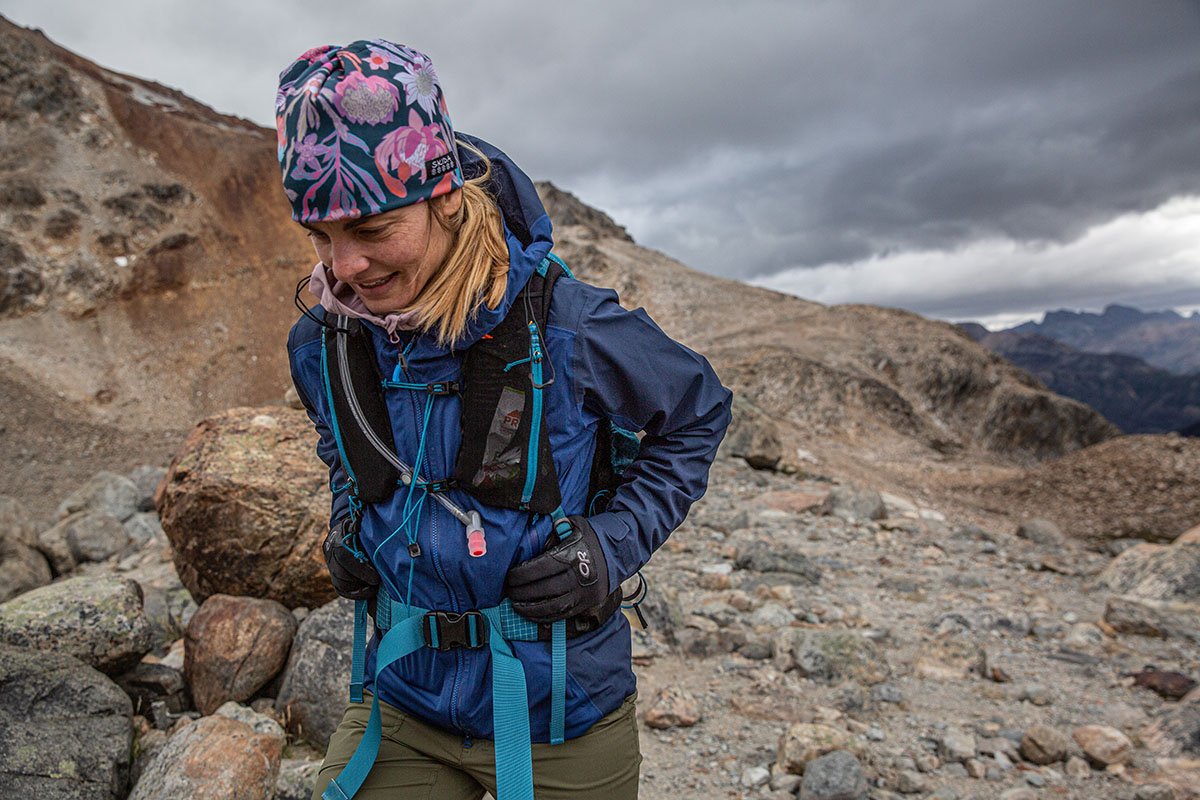
Unfortunately, many daypacks on the market only come in one size, including the REI Flash 22, Cotopaxi Batac, Osprey Daylite Plus, Free Range Equipment Canvas, and others from our picks above. It won’t be a dealbreaker for a lot of hikers, but the one-size-fits-most approach does mean you get less of a customized, close fit. And it’s worth noting that you still need to know your torso length for these designs, as manufacturers typically provide length ranges (and some one-size models have smaller ranges than others). Finally, many packs are offered in women’s-specific versions with different measurements than their men’s counterparts (we outline the benefits of choosing a women’s-specific daypack below).
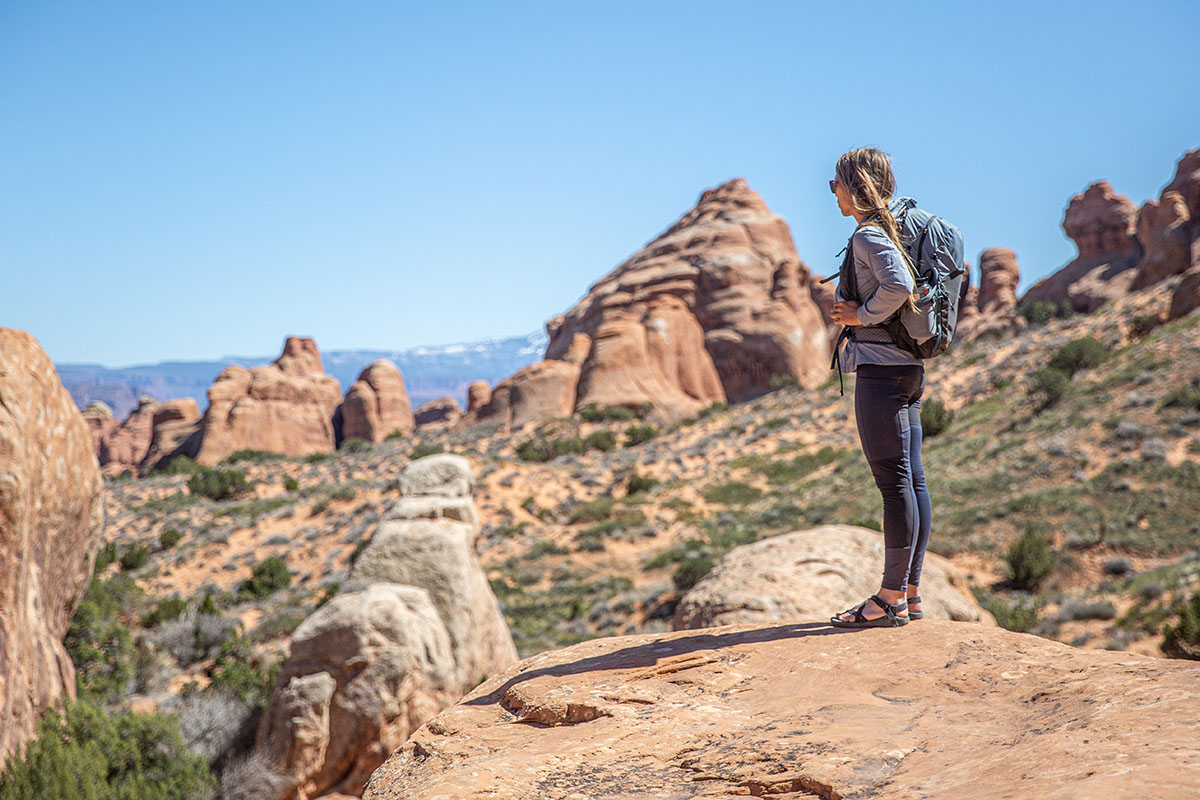
Plus and Extended-Size Daypacks
Hikers come in all shapes and sizes, and leading brands like Osprey and Gregory have risen to the occasion with dedicated plus-size versions of some of their core daypacks. From our list above, Osprey offers their Talon 22 and women’s Tempest 22 in Extended Fit variations that feature larger hipbelts, extended shoulder straps, repositioned pockets, and longer sternum straps than the straight-sized models. Gregory also offers several plus-size options, including a few capacities of the standard Nano daypack, which doesn’t come with a hydration bladder but is otherwise largely identical to the H2O model above. Gregory states their plus-size offerings are comparable to 2X to 6X in apparel sizing. Options still are fairly limited for plus-size hikers, but we’re happy to see these brands making a dedicated effort.
Much like their larger cousins, full-on backpacking packs, higher-capacity daypacks feature a metal or plastic frame. The frame creates a rigid or semi-rigid structure that doesn’t sag under weight (including items that you strap to the outside of the pack), which is great for those who carry extra gear on their all-day excursions. Frames are key for carrying heavy loads comfortably, as they help transfer weight to your hips (rather than shoulders) while hiking. Frame designs vary but are often a U-shaped, hoop style or a plastic framesheet, both of which define the perimeter of the pack and give it a stiff, rectangular shape.
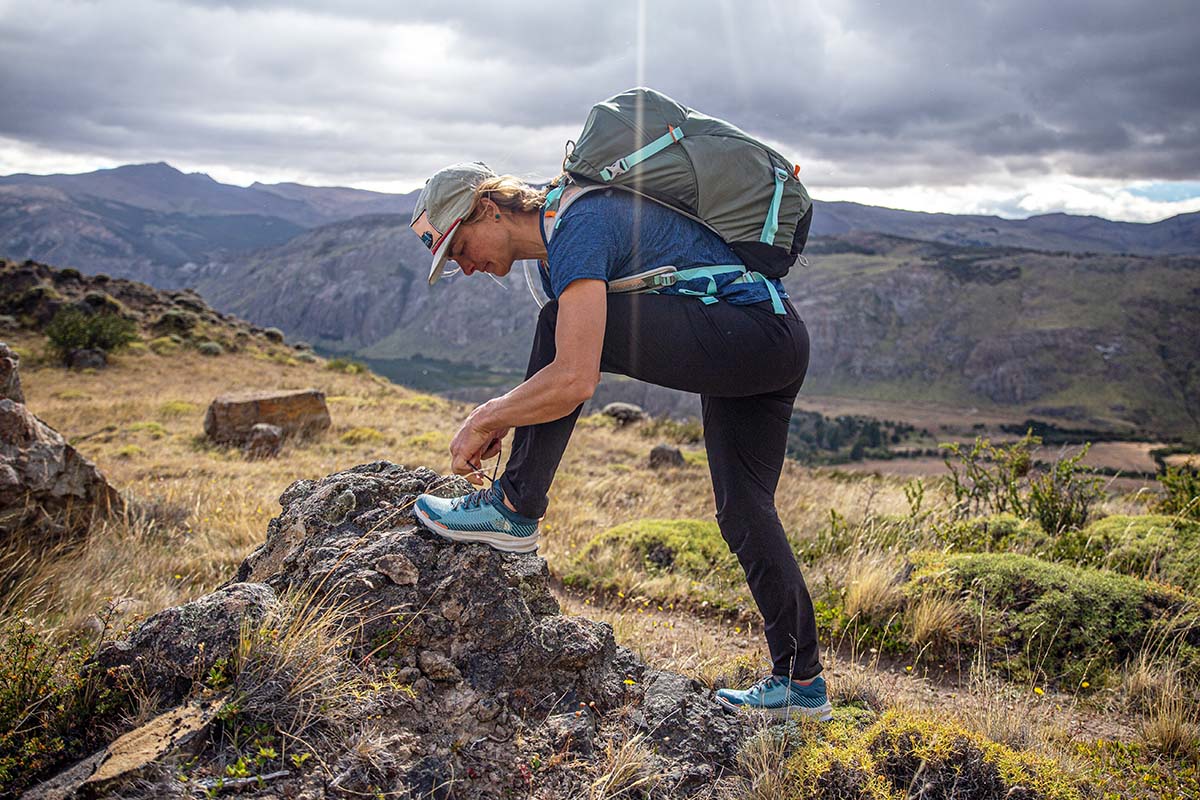
Having a frame isn’t always necessary, and very lightweight or small-capacity backpacks like the REI Flash 22 oftentimes go without. For the right person, this isn’t a sacrifice at all. A frame adds weight and complexity, and when you’re not hauling anything more than 10-15 pounds, a frame doesn’t benefit you very much. In addition, a padded backpanel can accomplish a similar goal of isolating you from the contents you’re carrying and defining the shape of the pack. We recommend getting a pack with a frame if you need the extra support or like the defined shape, but again, there are plenty of reasons to avoid one altogether.
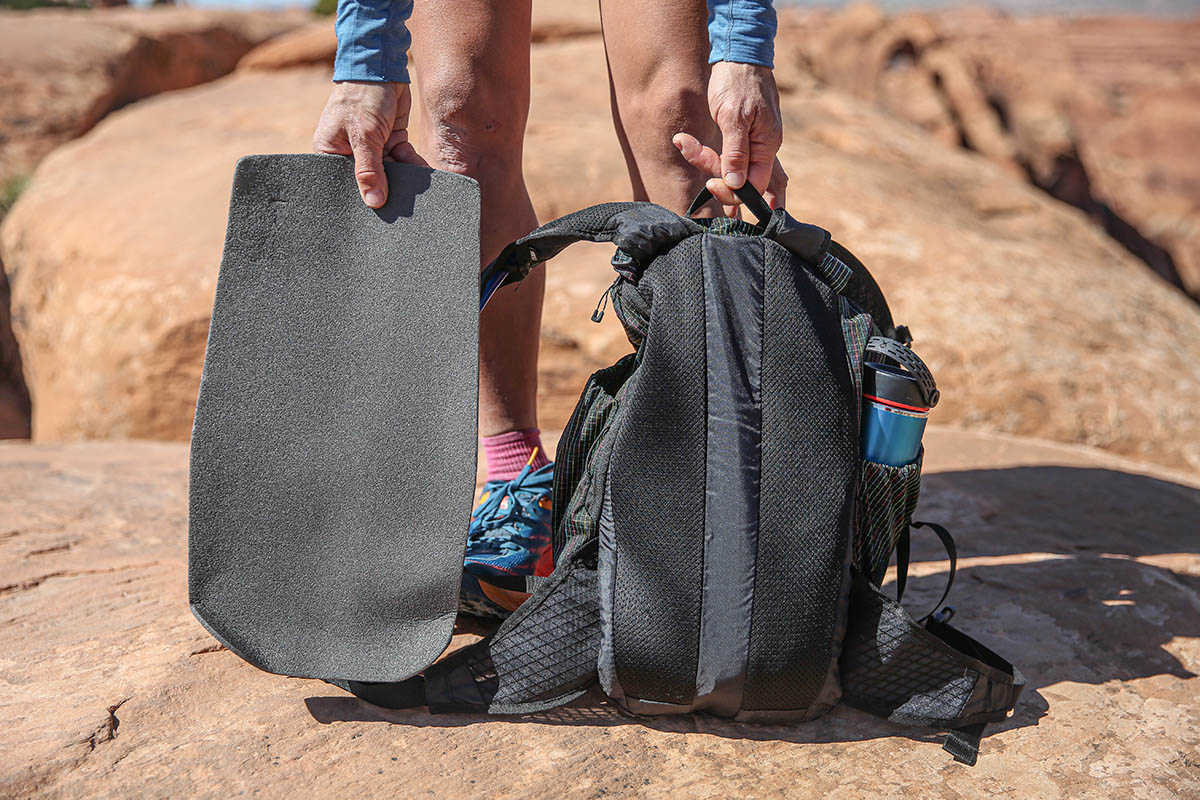
Typical daypacks will have some foam or mesh built into the backpanel (the area of the pack that comes into contact with your back) and a semi-rigid frame sheet providing structure. Ultralight packs will have either a flexible frame sheet and fabric backpanel for a little structure or no padding at all. The downside of these designs is that the pack can sag and won't protect you as well from bulky items in your pack. On the other hand, ultralight packs compress quite small and can be stowed in a travel pack or backpacking pack for day use.
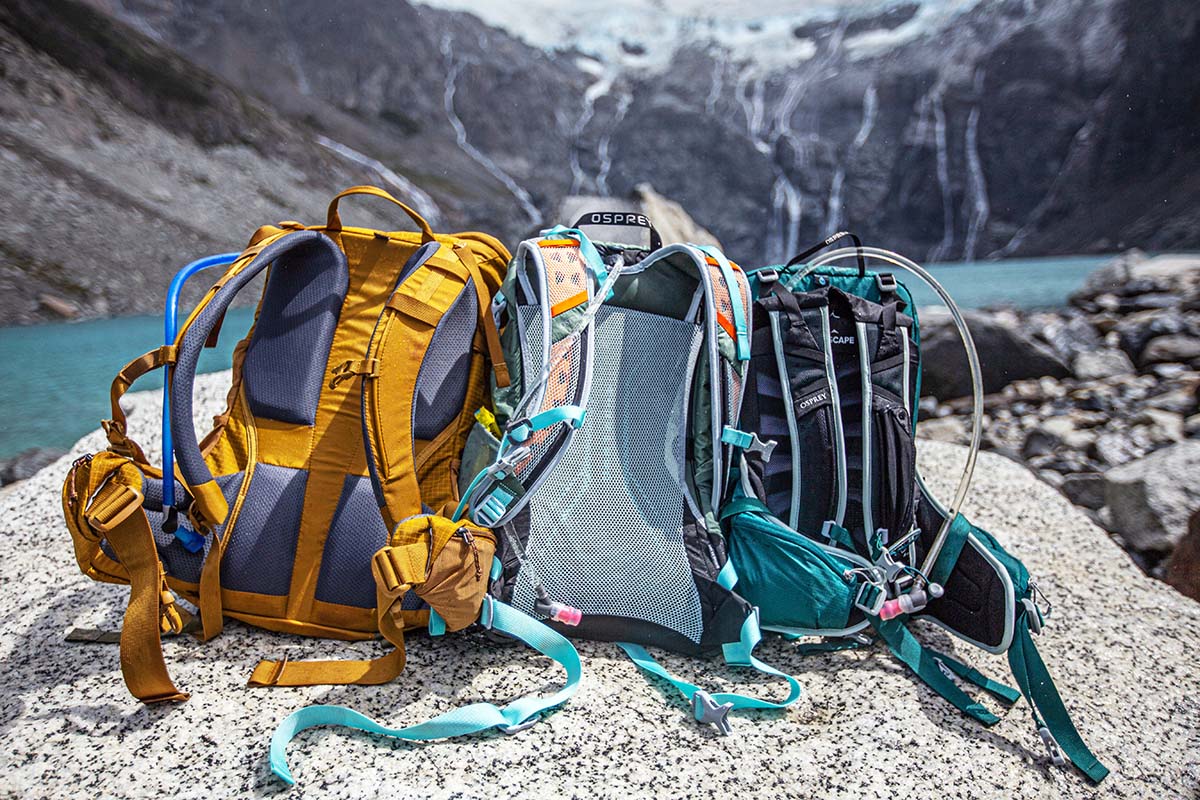
A third style is the fully ventilated backpanel. As opposed to either nylon or foam coming into contact with your back, ventilated backpanels are full-length mesh and your best defense against a sweaty back. Osprey has been a leader in ventilated packs, and we particularly like the design of the Osprey Stratos 36. The suspended mesh that contacts the length of your torso encourages airflow without pulling the weight of the pack too far away from your back, which was a problem with some early models. Ventilated designs do eat into the size and dimensions of the main compartment and are more expensive, but it’s worth it for some to keep the back of their shirt dry.
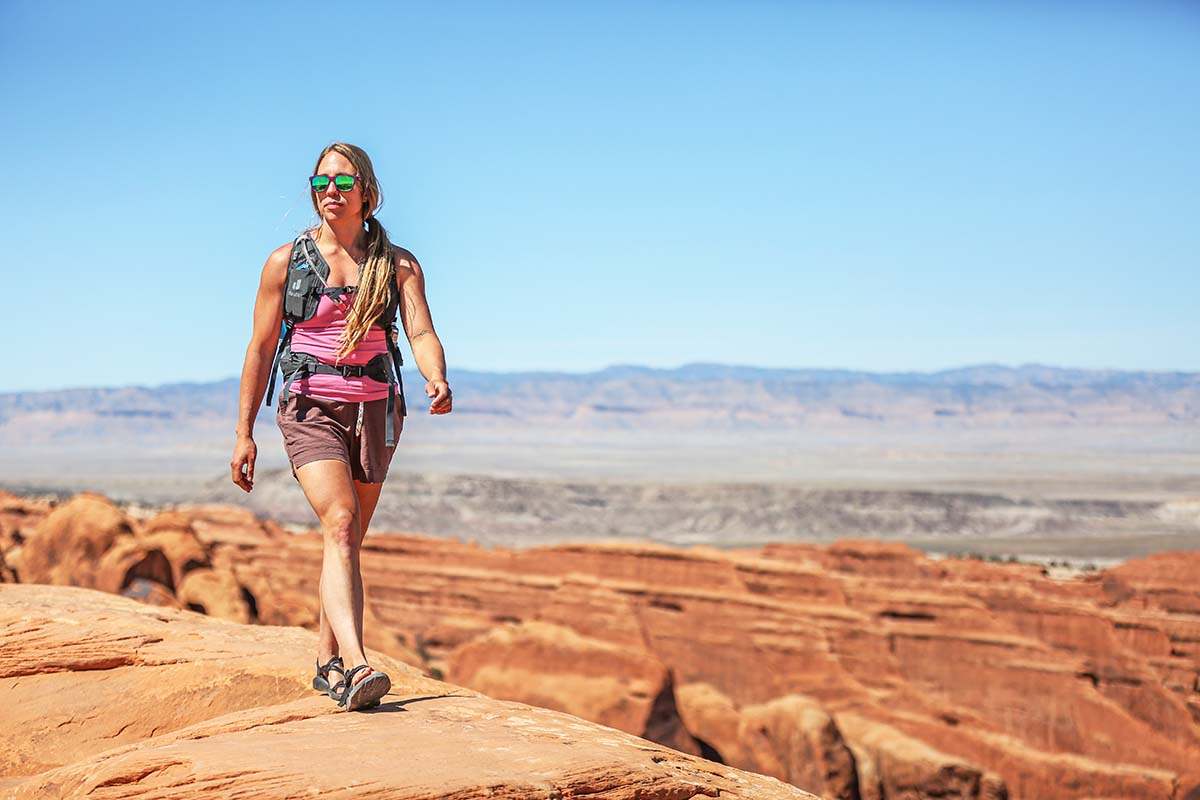
It’s common for our daypacks to be filled with items like a phone, camera, or down jacket that won’t do well in rain. As such, we put a high priority on water protection. The good news is that most daypacks are relatively water-resistant and can shed light to moderate moisture, but the fabrics and seams will start to give way in a downpour. Some packs come with a built-in rain cover that stows inside the bag (from our list, the Gregory Zulu 30, REI Co-op Traverse 35 and Trail 40, and Osprey Stratos have this feature). Alternatively, you can purchase a separate waterproof cover or use a pack liner to protect your gear from the inside.
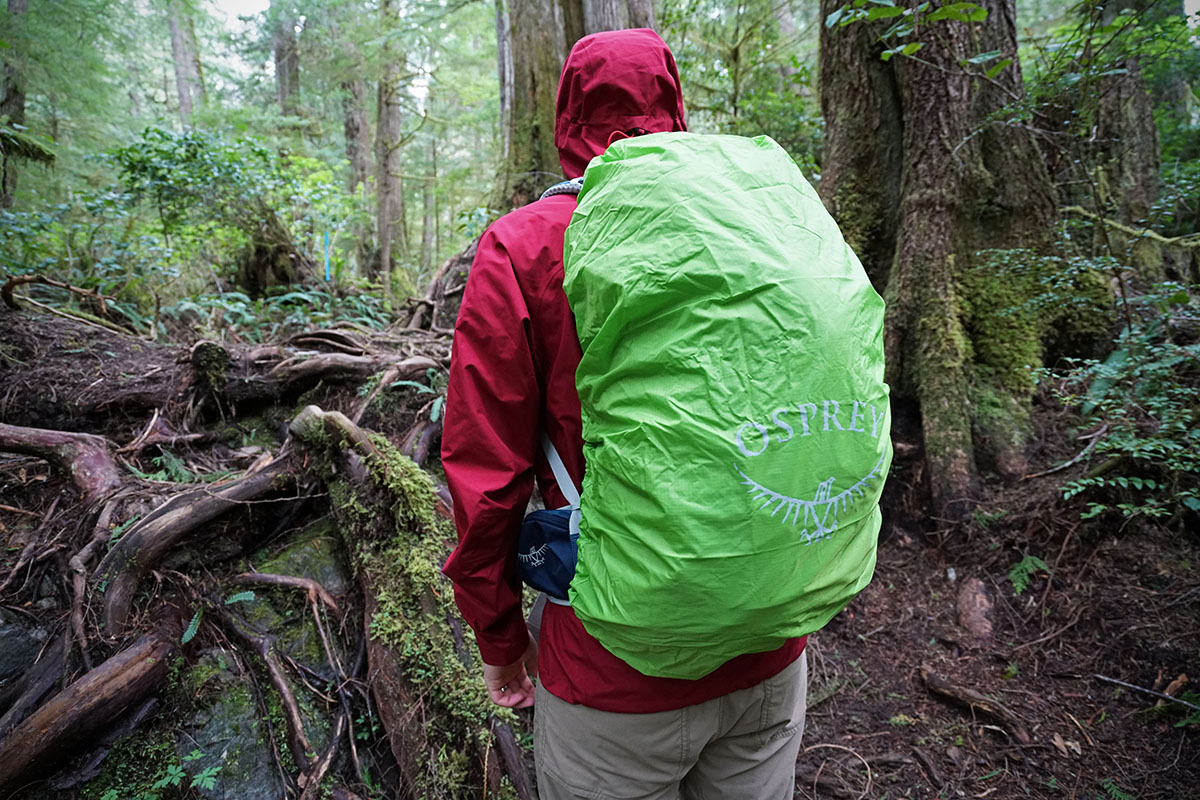
There are a small number of daypacks on the market made with waterproof materials, including the Hyperlite Daybreak and Osprey's Downburst. The Daybreak uses Dyneema fabrics, which are naturally water-resistant, while other packs often use a waterproof nylon and seam sealing along the interior to keep out moisture. The Downburst boasts an impressive IPX5 waterproof rating, making it impervious to anything but full submersion. However, what most waterproof packs have in common is a price in excess of $200. This high cost of entry is what keeps waterproof packs in limited numbers, but it may be worth it if you need the protection and want something more reliable than a rain cover.

A hydration-compatible pack is defined as having some way to store a hydration reservoir, including popular models like the CamelBak Crux or Platypus Big Zip Evo. Most traditional daypacks, like the Osprey Stratos, have a clip along the top of the interior of the bag and enough space to accommodate a 3-liter reservoir. And smaller packs like the Cotopaxi Batac 16L are best suited for a smaller-capacity reservoir (up to 2 liters), not only for space reasons but also total weight.
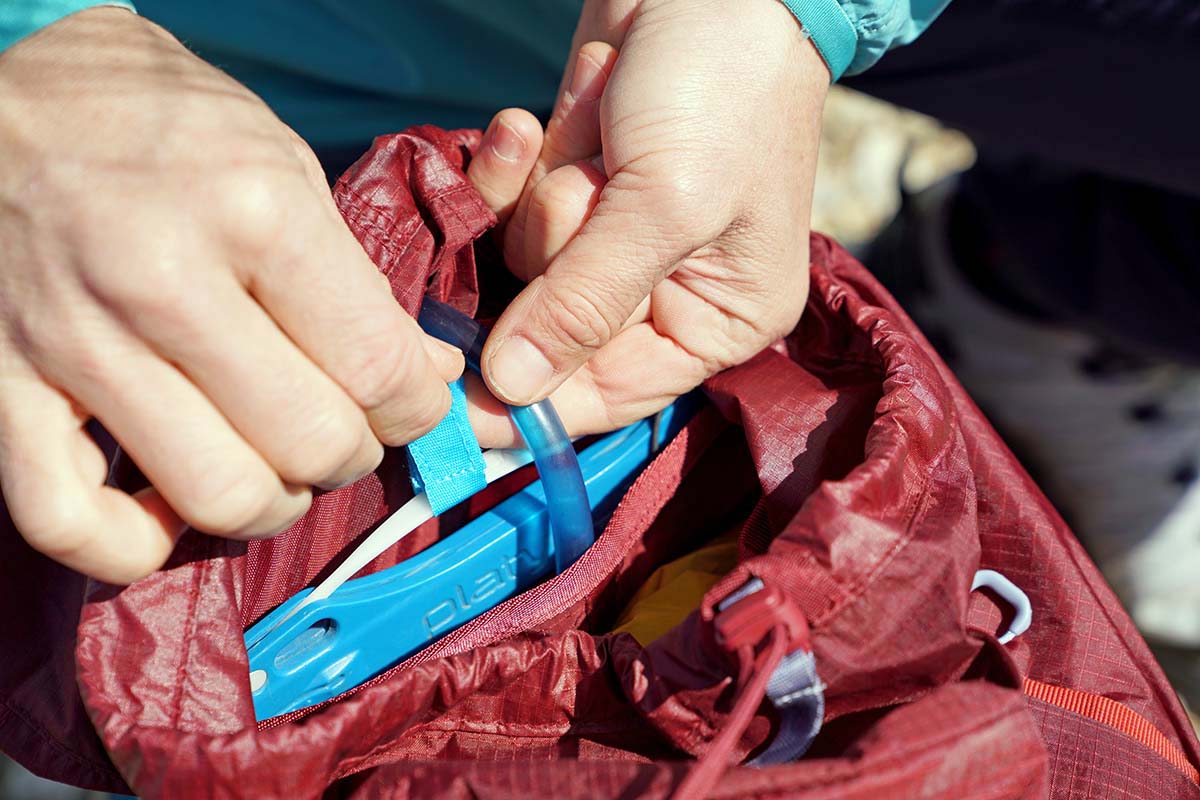
With the exception of ultralight options, most hydration-compatible packs have a sleeve to slide in and hold the hydration reservoirs. It’s a simple process: Attach the bladder to the top clip and insert into the sleeve. The hose can then be routed through an opening in the top of the pack. And if you don't already own a reservoir, choosing a hydration daypack like the Osprey Skarab 30 gets you a solid pack as well as a reputable 2.5-liter Hydraulics LT system (which is made by hydration leader HydraPak). For a full list of our top picks in this category, see our article on the best hydration packs.
If you like to have a defined space for and easy access to smaller items, look for a pack with a number of interior and exterior pockets. We like hipbelt pockets for things you want close at hand, an exterior pocket along the top lid for small items like a headlamp or multi-tool, and a large, open main compartment for our gear. For school or daily use, additional exterior pockets with a key clip are always handy.

One of our favorite pack features is a large exterior mesh pocket along the front of the pack known as a “shove-it” pocket. This expandable space is great for items you may need quick access to like a rain jacket or snack. In addition, you can throw wet items into this outer pocket to avoid ruining the contents of your main compartment. Minimalist designs omit many organization features—sometimes including the shove-it pocket—so keep an eye out for the number of internal and external pockets if those are important to you.
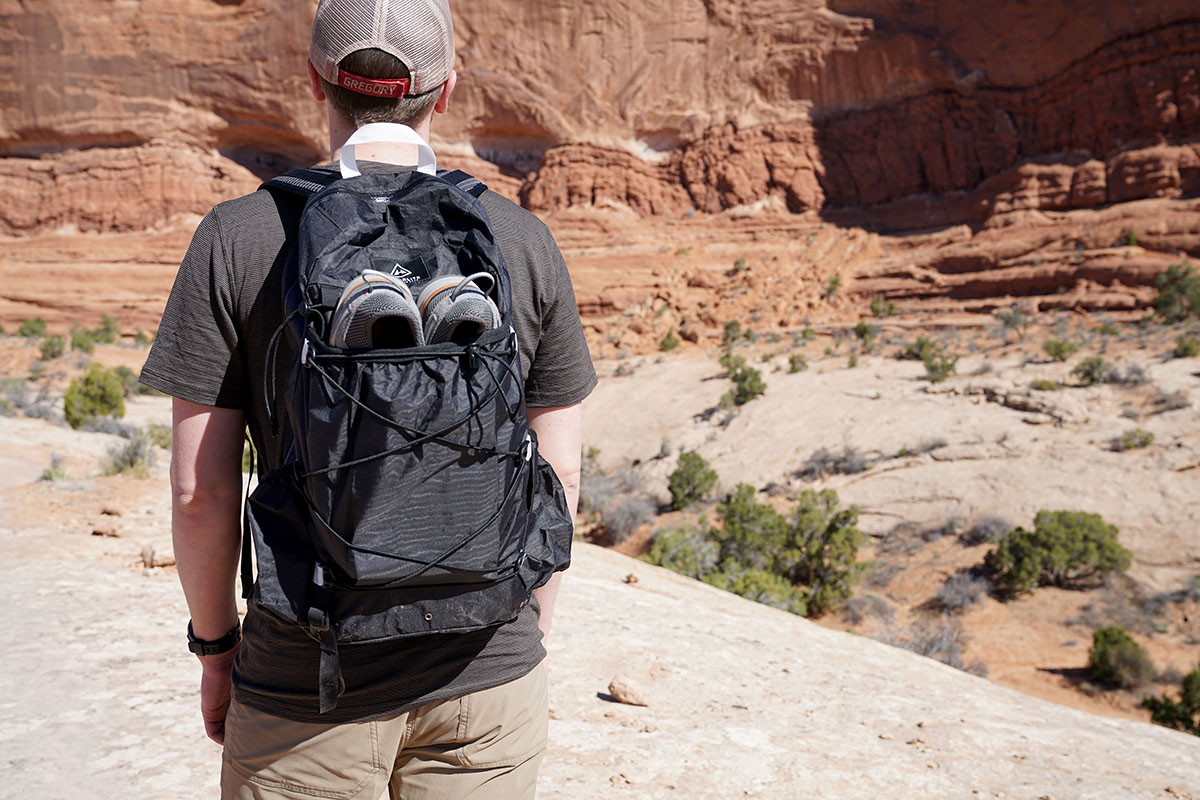
Running Vest-Inspired Pockets
We’d be remiss not to touch on running vest-inspired storage, which is a rapidly growing trend among daypacks. From our list above, the Arc’teryx Aerios 35, Nemo Persist 30L, Deuter Speed Lite Pro 25, and Black Diamond Distance 15 all boast front pockets on the shoulder straps (similar to running vests) that allow for easy on-the-go access to snacks and other small necessities. We’re generally big fans of this type of storage, although some designs are better executed than others. Regardless of which option you choose, the front pockets do add a bit of a technical slant (these packs aren’t the best for crossing over for casual use), but serious day hikers will likely find the added convenience worth that trade-off.
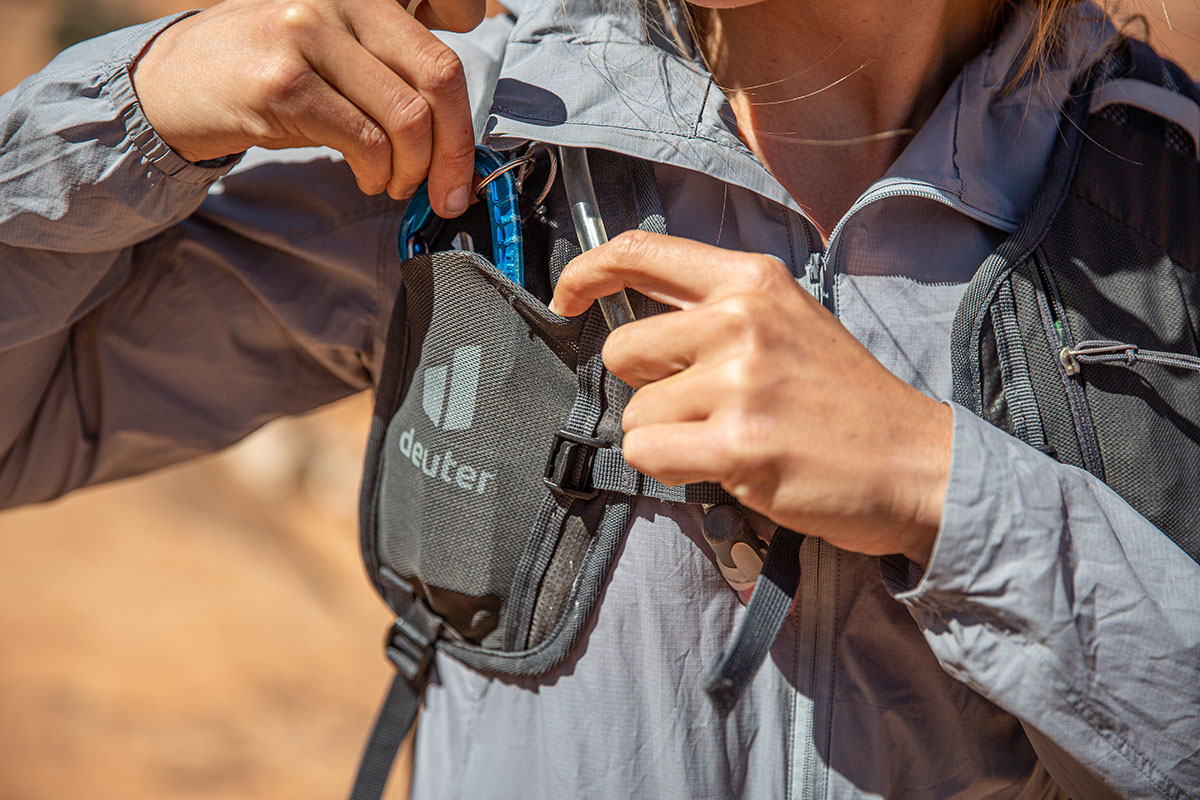
All daypacks that made our list have access to the main compartment through the top of the pack, but the closure systems vary. Roll-top lids and drawcord systems are popular on minimalist packs, while fully featured bags typically use zippers. Roll-top lids and zippers are the most secure for protecting what’s inside your pack, but a well-made drawcord system like the REI Co-op Flash 22 is simple, lightweight, and very easy to use. One advantage that a roll-top pack has over the other options is compressibility: You can change the interior volume of the pack with the number of times you fold the lid.

All three closure systems above are associated with a top-loading pack, which as the name would indicate, opens at the top of the bag. In addition, there are a few packs that made our list that are considered panel loaders. That means that the lid to the main compartment can be zipped open and pulled back like a suitcase, which allows for easy access to contents at both the top and bottom of the bag. The downside is extra weight and expense (and zippers can break and fail over time), but a number of our favorite medium- to large-capacity packs have this feature.
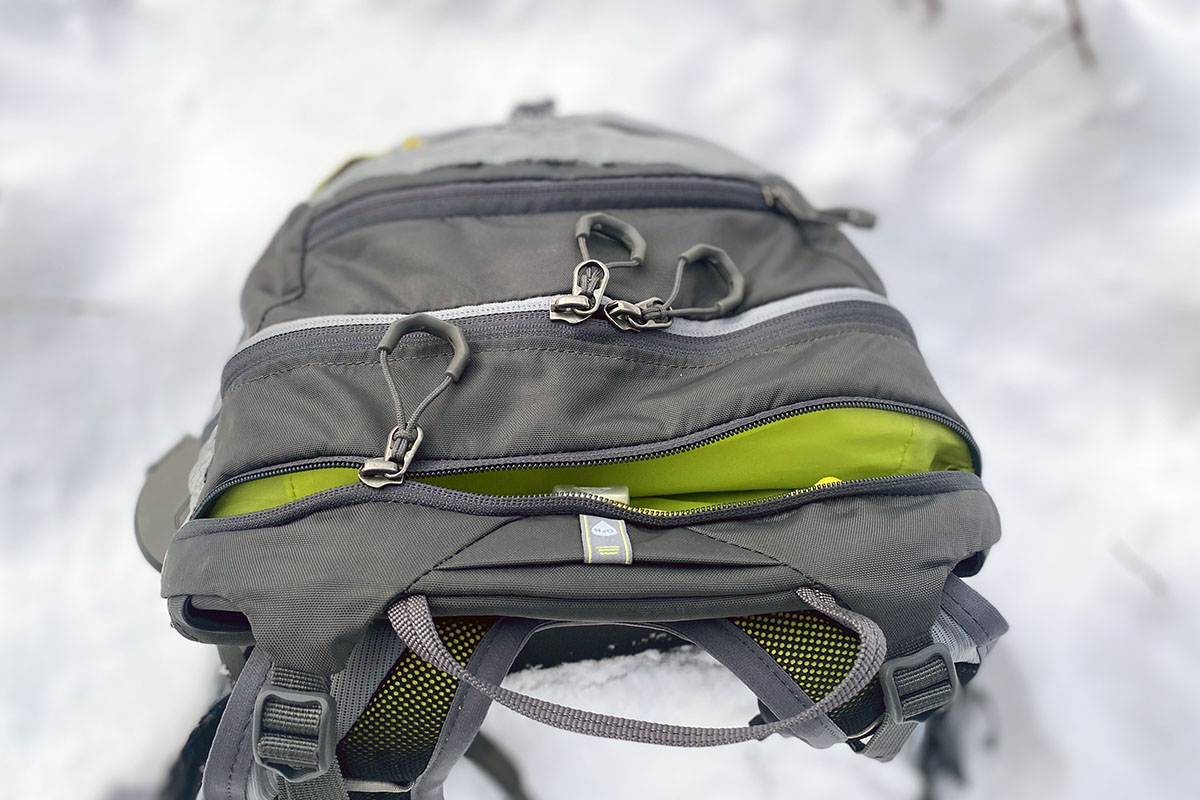
Our impact on the environment has never been of greater concern, and we appreciate that many leading gear companies are stepping up with more sustainable production practices. The use of recycled fabrics has grown substantially in the past few years, with brands like REI Co-op, Osprey, Gregory, and Deuter prioritizing these materials. Cotopaxi is another leader in this realm, and all of their Del Día packs (including the Batac above) are made with repurposed fabrics. We're also seeing a lot more PFAS-free durable water repellent (DWR) finishes on daypacks, which eliminate the use per- or polyfluorinated chemicals (these “forever chemicals” have been linked to a range of environmental and health issues). With many states stepping up to ban the sale of items that include PFAS, the outdoor industry is seeking better solutions for water- and stain-resistant finishes (you can read more about Patagonia’s take on the issue here).

Women’s daypacks are not, as they may appear, just a colorful version of a men’s or unisex pack. There are real design differences with tangible benefits that deserve mentioning. The advantages include a torso fit that is often a better size than the sometimes large and bulky unisex models, and shoulder straps and hipbelts have been designed specifically for women. Men with shorter torsos often get a better fit with a women’s-specific model as well.
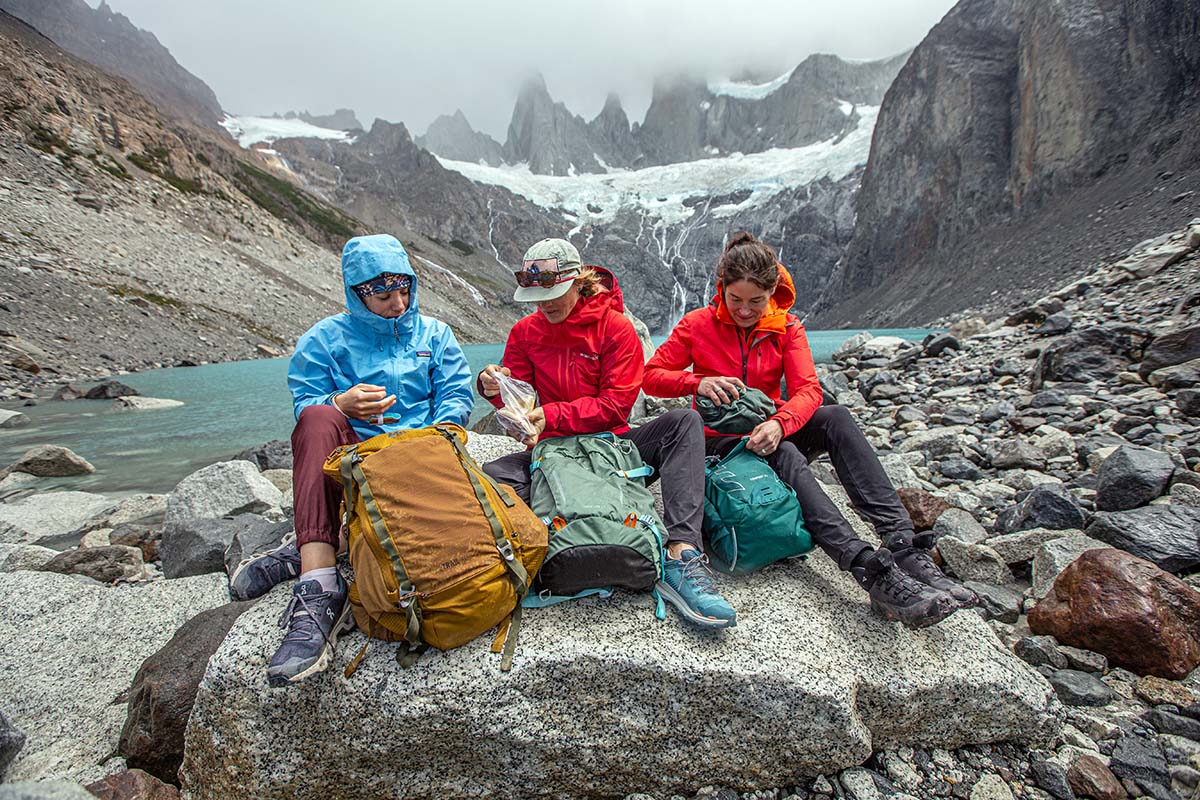
Typically, if you’ll be using the pack for pretty serious day hikes, it’s well worth opting for a high-end women’s model like Gregory's Jade 28, Deuter's Speed Lite Pro 23 SL, Osprey's Sirrus 36, Tempest 22, and Skimmer 28 we’ve listed above. The more tuned fit makes for a more comfortable carrying experience. For casual use, such as travel or when you’re packing light, it’s not as big a deal. Something like the unisex REI Flash 22 should work just fine. For a complete look at the market, check out our article on the best women's hiking daypacks.
Back to Our Top Daypack Picks Back to Our Daypack Comparison Table